This document provides an overview of project management. It defines a project as a temporary endeavor undertaken to create a unique product or service, and defines project management as applying knowledge, skills, tools, and techniques to project activities to meet requirements. It discusses how technology is driving organizations to develop new products and services through projects more quickly. It also notes that project management involves understanding complex interrelations between activities and how actions in one area affect others.


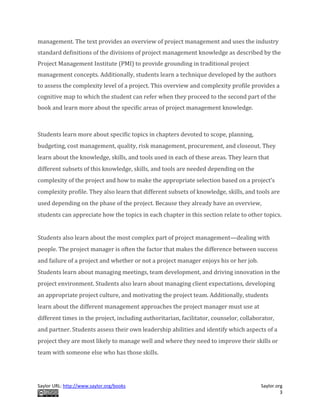



![Saylor URL: http://www.saylor.org/books Saylor.org
7
1.1 Project Management Defined
LEARNING OBJECTIVES
1. Identify the Project Management Institute’s definition of project management.
2. Analyze and evaluate the role of client expectations in a project.
3. Define project scope.
“Project management is the application of knowledge, skills, tools, and techniques to
project activities to meet the project requirements.” [1] This simple definition represents a
compromise that resulted from intense discussions within
the Project Management Institute (PMI) during the 1980s. One of the priorities of PMI
during this time was the development of project management as a profession. Although
debate continues on whether project management is a profession with an enforceable code
of conduct and other traditional criteria for recognition as a profession, the development
of A Guide to the Project Management Body of Knowledge (PMBOK Guide) and the project
management certifications that derived from these efforts helped promote the
understanding and development of the project management field.
The discussion about what should be in the definition of project management included
debates about the purpose of project management. Is the main purpose to meet client
expectations or is the main purpose to meet the written specifications and requirements?
This discussion around meeting project requirements was not easily settled. If it is
assumed that the project client is the one who defines project requirements, then maybe
project management is the application of knowledge, skills, tools, and techniques to meet
client requirements or client expectations. PMI’s definition of project management does
provide a good understanding of project management, but it does not help us understand
project success. For that, we must include the client.](https://image.slidesharecdn.com/projectmanagement-fromsimpletocomplex-150108153836-conversion-gate02/85/Project-management-from-simple-to-complex-7-320.jpg)
![Saylor URL: http://www.saylor.org/books Saylor.org
8
Jack Meredith and Samuel Mantel [2] discussed project management in terms of producing
project outcomes within the three objectives of cost, schedule, and specifications. Project
managers are then expected to develop and execute a project plan that meets cost,
schedule, and specification parameters. According to this view, project management is the
application of everything a project manager does to meet these parameters. This approach
to defining project management shares PMI’s focus on the project outcomes in terms of
requirements.
Meredith and Mantel added a fourth aspect of project management—the expectations of
the client. One client-centered definition of project management is the application of
knowledge, skills, tools, and techniques to meet or exceed the expectations of the client.
This definition focuses on delivering a product or service to the client that meets
expectations rather than project specifications. It is possible to meet all project
specifications and not meet client expectations or fail to meet one or more specifications
and still meet or exceed a client’s expectation. [3]
Meredith and Mantel discussed a tendency noted by Darnall [4] that expectations often
increase during the life of a project. Meredith and Mantel suggest that this is a form of
scope increase. Aproject scope is a carefully crafted document that reflects the
performance specifications of the project deliverables. Defining the project scope and
managing scope change is a very different process from developing an understanding of a
client’s expectations and managing those expectations. Darnall focused on defining and
managing client expectations as a critical project management skill that is distinct from
scope development and management.
Client expectations encompass an emotional component that includes many client desires
that are not easily captured within a specification document. Although closely correlated
with project specifications, client expectations are driven by different needs. It is possible
for a project team to exceed every project specification and end up with an unsatisfied
client.
Highway Project](https://image.slidesharecdn.com/projectmanagement-fromsimpletocomplex-150108153836-conversion-gate02/85/Project-management-from-simple-to-complex-8-320.jpg)


![Saylor URL: http://www.saylor.org/books Saylor.org
11
What are the differences between the two projects? Provide a bulleted list.
Identify the single most important difference between the two projects that affected
client satisfaction.
Suggest an approach to managing client expectations in the highway project that
might have resulted in meeting or exceeding expectations rather than
disappointment.
[1] Project Management Institute, Inc., A Guide to the Project Management Body of
Knowledge (PMBOK Guide), 4th ed. (Newtown Square, PA: Project Management Institute,
Inc., 2008), 6.
[2] Jack R. Meredith and Samuel J. Mantel, Jr., Project Management: A Managerial
Approach (Hoboken, NJ: Wiley, 2006), 8.
[3] Russell W. Darnall, The World’s Greatest Project (Newtown Square, PA: Project
Management Institute, Inc., 1996), 48–54.
[4] Russell W. Darnall, The World’s Greatest Project (Newtown Square, PA: Project
Management Institute, Inc., 1996), 48–54.
1.2 Project Defined
LEARNING OBJECTIVES
1. Describe two defining characteristics of a project.
2. Organize projects within projects.
The Project Management Institute (PMI) defines a project by its two key characteristics. All
projects are temporary and undertaken to create a product, service, or result that is
unique. [1]These two simple concepts create a work environment that mandates different](https://image.slidesharecdn.com/projectmanagement-fromsimpletocomplex-150108153836-conversion-gate02/85/Project-management-from-simple-to-complex-11-320.jpg)
![Saylor URL: http://www.saylor.org/books Saylor.org
12
management approach from that used by an operations manager, whose work is oriented
toward continuous improvement of existing processes over longer periods of time.
A project manager needs a different set of skills to both define and successfully execute
temporary projects. Because projects are temporary, they have a defined beginning and
end. Project managers must manage start-up activities and project closeout activities. The
processes for developing teams, organizing work, and establishing priorities require a
different set of knowledge and skills because members of the project management team
recognize that it is temporary. They seldom report directly to the project manager and the
effect of success or failure of the project might not affect their reputations or careers the
same way that the success or failure of one of their other job responsibilities would.
The second characteristic of a project, the delivery of a unique product, service, or result,
also changes the management approach to the work. A project manager must take time to
understand the deliverables of a project, develop a plan for producing the deliverables in
the time available, and then execute that plan.
Projects are also defined within the context of larger projects as the following example
illustrates.
National Energy Plan
The National Energy Technology Laboratory laid out a plan for a national energy policy
that had a clear and identifiable outcome—providing reliable, affordable, and
environmentally sound energy. [2] The details of this plan will be revised and updated, but
the general goals are likely to remain unchanged. To accomplish these goals, the project
requires the development of new technologies, complex scheduling and cost control,
coordination of a large number of subcontractors, and skillful stakeholder management.
Development of each of the major components became a project for the winning
contractors within the larger project of providing reliable, affordable, and environmentally](https://image.slidesharecdn.com/projectmanagement-fromsimpletocomplex-150108153836-conversion-gate02/85/Project-management-from-simple-to-complex-12-320.jpg)

![Saylor URL: http://www.saylor.org/books Saylor.org
14
3. Projects can contain ___________ projects.
4. What are two defining characteristics of a project that distinguish it from a process?
5. If you were planning to move from your current apartment or home to another
location, would this qualify as a project? Explain your answer.
Projects within Projects
Choose a large public works project such as the construction of a new high school.
Identify at least five phases to this project that could be treated as projects within a
project. Specifically state how each project meets the definition of a project, and
describe the product, service, or result of each project and why it is temporary.
[1] Project Management Institute, Inc., A Guide to the Project Management Body of Knowledge
(PMBOK Guide), 4th ed. (Newtown Square, PA: Project Management Institute, Inc., 2008), 5.
[2] National Energy Technology Laboratory, “Reliable, Affordable, and Environmentally Sound
Energy for America’s Future,” The Energy Lab,
2001, http://www.netl.doe.gov/publications/press/2001/nep/nep.html(accessed June 18,
2009).
1.3 Project Context
LEARNING OBJECTIVES
1. Identify the effect of organization type on time horizons.
2. Compare project management and operations management.
3. Describe the organizational options for managing projects.
The project is affected by the type of organization in which the project is conducted and
how the organization is organized to manage projects.
Organizational Priorities](https://image.slidesharecdn.com/projectmanagement-fromsimpletocomplex-150108153836-conversion-gate02/85/Project-management-from-simple-to-complex-14-320.jpg)





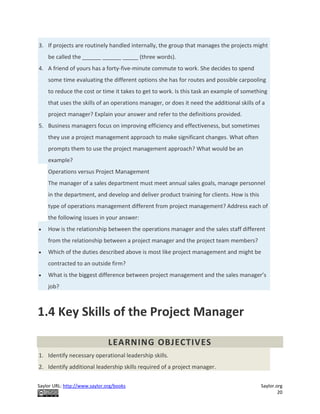
![Saylor URL: http://www.saylor.org/books Saylor.org
21
Every project is unique, and most projects will encounter unexpected technical challenges.
Each project management team is a group of individuals who need motivation and
coordination. Planning is vital, but the ability to adapt to changes and work with people to
overcome challenges is just as necessary. A project manager must master the skills that are
necessary to be successful in this environment.
Operational Management Skills
Often the difference between the project that succeeds and the project that fails is the
leadership of the project manager. The leadership skills needed by the successful project
manager include all the skills needed by operations managers of organizations. These skills
include:
Good communication
Team building
Planning
Expediting
Motivating
Political sensitivity
Project Management Skills
Because project managers generally operate in a project environment that is more time
sensitive and goal driven, the successful project manager requires additional knowledge,
skills, and abilities.
Albert Einsiedel [1] discussed leader-sensitive projects and defined five characteristics of an
effective project leader. These characteristics were chosen based on some assumptions
about projects. These characteristics include the project environment, which is often a](https://image.slidesharecdn.com/projectmanagement-fromsimpletocomplex-150108153836-conversion-gate02/85/Project-management-from-simple-to-complex-21-320.jpg)
![Saylor URL: http://www.saylor.org/books Saylor.org
22
matrix organization that results in role ambiguity, role conflict, and role erosion. The
project environment is often a fluid environment where decisions are made with little
information. In this environment, the five characteristics of an effective project leader
include the following:
Credibility
Creativity as a problem solver
Tolerance for ambiguity
Flexibility in management style
Effectiveness in communicating
Hans Thamhain [2] researched the training of project managers and, based on the finding,
categorized project management into interpersonal, technical, and administrative skills:
Interpersonal skills. These skills include providing direction, communicating, assisting with
problem solving, and dealing effectively with people without having authority.
Technical expertise. Technical knowledge gives the project manager the creditability to
provide leadership on a technically based project, the ability to understand important
aspects of the project, and the ability to communicate in the language of the technicians.
Administrative skills. These skills include planning, organizing, and controlling the work.
Thamhain’s work provides a taxonomy for better understanding the skills needed by
project managers.
Traditionally, the project manager has been trained in skills such as developing and
managing the project scope, estimating, scheduling, decision making, and team building.
Although the level of skills needed by the project manager depends largely on the project
profile, increasingly the people skills of the project manager are becoming more important.
The skills to build a high-performing team, manage client expectations, and develop a clear
vision of project success are the type of skills needed by project managers on more
complex projects. “To say Joe is a good project manager except he lacks good people skills
is like saying he’s a good electrical engineer but doesn’t really understand electricity.” [3]](https://image.slidesharecdn.com/projectmanagement-fromsimpletocomplex-150108153836-conversion-gate02/85/Project-management-from-simple-to-complex-22-320.jpg)

![Saylor URL: http://www.saylor.org/books Saylor.org
24
5. Motivating others
6. Sensitive to the politics of a situation
Additional project management skills:
7. Establish credibility with others
8. Find creative solutions to problems
9. Tolerate ambiguity
10. Use a flexible management style—adapt your management style to changing
situations
[1] Albert A. Einsiedel, “Profile of Effective Project Managers,” Project Management Journal 18
(1987): 5.
[2] Hans J. Thamhain, “Developing Project Management Skills,” Project Management Journal 22
(1991): 3.
[3] Russell W. Darnall, “The Emerging Role of the Project Manager,” PMI Journal (1997): 64.
1.5 Introduction to the Project
Management Knowledge Areas
LEARNING OBJECTIVES
1. Identify the tasks performed in a project start-up.
2. Describe the areas of project management knowledge as defined by the Project
Management Institute.
Projects are divided into components, and a project manager must be knowledgeable in
each area. Each of these areas of knowledge will be explored in more depth in subsequent
chapters.
Project Start-Up and Integration](https://image.slidesharecdn.com/projectmanagement-fromsimpletocomplex-150108153836-conversion-gate02/85/Project-management-from-simple-to-complex-24-320.jpg)

![Saylor URL: http://www.saylor.org/books Saylor.org
26
environment that encourages team members to fully engage in the project and encourages
innovative approaches to developing the project plan.
Project Scope
The project scope is a document that defines the parameters—factors that define a system
and determine its behavior—of the project, what work is done within the boundaries of the
project, and the work that is outside the project boundaries. The scope of work (SOW) is
typically a written document that defines what work will be accomplished by the end of the
project—the deliverables of the project. The project scope defines what will be done, and
theproject execution plan defines how the work will be accomplished.
No template works for all projects. Some projects have a very detailed scope of work, and
some have a short summary document. The quality of the scope is measured by the ability
of the project manager and project stakeholders to develop and maintain a common
understanding of what products or services the project will deliver. The size and detail of
the project scope is related to the complexity profile of the project. A more complex project
often requires a more detailed and comprehensive scope document.
According to the Project Management Institute, [1] the scope statement should include the
following:
Description of the scope
Product acceptance criteria
Project deliverables
Project exclusions
Project constraints
Project assumptions](https://image.slidesharecdn.com/projectmanagement-fromsimpletocomplex-150108153836-conversion-gate02/85/Project-management-from-simple-to-complex-26-320.jpg)








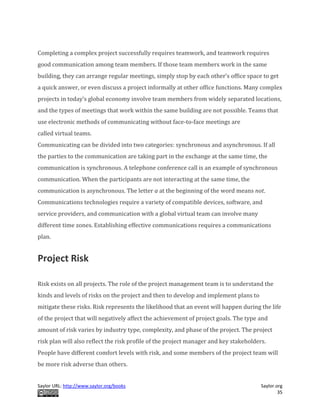
![Saylor URL: http://www.saylor.org/books Saylor.org
36
The first step in developing a risk management plan involves identifying potential project
risks. Some risks are easy to identify, such as the potential for a damaging storm in the
Caribbean, and some are less obvious. Many industries or companies have risk checklists
developed from past experience. The Construction Industry Institute published a one-
hundred-item risk checklist [2]that provides examples and areas of project risks. No risk
checklist will include all potential risks. The value of a checklist is the stimulation of
discussion and thought about the potential risks on a project.
The project team then analyzes the identified risks and estimates the likelihood of the risks
occurring. The team then estimates the potential impact of project goals if the event does
occur. The outcome from this process is a prioritized list of estimated project risks with a
value that represents the likelihood of occurrence and the potential impact on the project.
The project team then develops a risk mitigation plan that reduces the likelihood of an
event occurring or reduces the impact on the project if the event does occur. The risk
management plan is integrated into the project execution plan, and mitigation activities are
assigned to the appropriate project team member. The likelihood that all the potential
events identified in the risk analysis would occur is extremely rare. The likelihood that one
or more events will happen is high.
The project risk plan reflects the risk profile of the project and balances the investment of
the mitigation against the benefit for the project. One of the more common risk mitigation
approaches is the use of contingency. Contingency is funds set aside by the project team to
address unforeseen events. Projects with a high-risk profile will typically have a large
contingency budget. If the team knows which activities have the highest risk, contingency
can be allocated to activities with the highest risk. When risks are less identifiable to
specific activities, contingency is identified in a separate line item. The plan includes
periodic risk plan reviews during the life of the project. The risk review evaluates the](https://image.slidesharecdn.com/projectmanagement-fromsimpletocomplex-150108153836-conversion-gate02/85/Project-management-from-simple-to-complex-36-320.jpg)



![Saylor URL: http://www.saylor.org/books Saylor.org
40
4. Cost
5. Quality
6. Team selection (human resources)
7. Communications
8. Risk
9. Procurement
[1] Project Management Institute, Inc., A Guide to the Project Management Body of Knowledge
(PMBOK Guide), 4th ed. (Newtown Square, PA: Project Management Institute, Inc., 2008), 115–
16.
[2] Construction Industry Institute Cost/Schedule Task Force, Management of Project Risks and
Uncertainties(Austin, TX: Construction Industry Institute, 1989).
1.6 Exercises
Exercises at the end of the chapter are designed to strengthen your understanding and
retention of the information recently acquired in the chapter.
ESSAY QUESTIONS
Write several paragraphs to provide more in-depth analysis and consideration when
answering the following questions.
1. If you were planning to change the landscaping around the location where you or a
friend lives and decided to approach it like a project, describe the start-up activities
you would use. Refer to the elements of a project start-up as described in this chapter.
2. Describe a project you have worked on where you experienced scope creep. Begin by
defining scope creep in your own words. Describe the project, how the scope creep
occurred, and the effect it had on the project cost, quality, and completion date.](https://image.slidesharecdn.com/projectmanagement-fromsimpletocomplex-150108153836-conversion-gate02/85/Project-management-from-simple-to-complex-40-320.jpg)
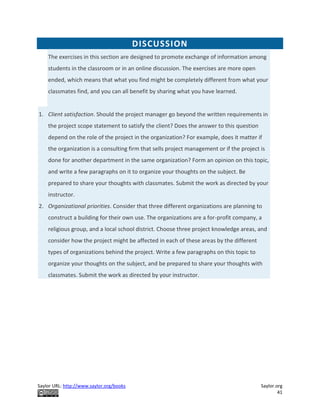
![Saylor URL: http://www.saylor.org/books Saylor.org
42
2.1 Using a Project Profile
LEARNING OBJECTIVES
1. Identify project attributes that can be used for project profiling.
2. Define project profiling.
A few years ago, I observed a project manager with a long list of successful projects
absolutely struggle with a project. As I looked around, I noticed that often times project
managers who do superb jobs on some projects will fail on others. What causes this to
happen? Why were project managers successful on some projects but struggling on others?
Even though all projects are by definition unique, there are attributes that are common
among projects that allow the characterization or profiling of a project. We can look at just
two project attributes and develop some understanding of the project. A large project that
will be executed in at least three locations will have a very different profile from a small
project that will be executed in one location. These two attributes—size and location—
provide information about the project that will enable a manager in the parent
organization to assign a project manager with the appropriate knowledge and skills. We
can then develop an execution approach to increase the likelihood of success.
Project managers have not always been assigned to projects based on their skills and the
skills required by the project. Research by the Construction Industry Institute [1] indicated
that the number one criterion for assignment of a project manager to a project was
availability. Even if available, the ideal project manager for a large construction project may](https://image.slidesharecdn.com/projectmanagement-fromsimpletocomplex-150108153836-conversion-gate02/85/Project-management-from-simple-to-complex-42-320.jpg)


![Saylor URL: http://www.saylor.org/books Saylor.org
45
[1] Construction Industry Institute, “Executive Summary,” RR103-11—Optimizing Project
Organizations, 2009, https://www.construction-
institute.org/scriptcontent/more/rr103_11_more.cfm (accessed June 18, 2009).
2.2 Project Profiling Models
LEARNING OBJECTIVE
1. Identify different methods of typing projects.
Aaron J. Shenhar and Dov Dvir [1] developed a typology—classification or profile—of
engineering projects that reflected two dimensions. The first dimension reflected the
technological uncertainty and ranged from low tech, medium tech, and high tech to super
high tech. Although projects involve the use of various levels of technology, Shenhar and
Dvir develop criteria for each type of technological uncertainty that enabled the project to
be typed. The second dimension reflected the system scope. The system scope dimension
ranged from assembly projects that dealt with building a single component, to system
projects that included interactive elements, to array projects that included a wide dispersal
of interactive systems and subsystems.
Shenhar and Dvir observed that the project execution approach was connected to the
project type. The study identified different management patterns associated with project
type as well as different management tools and practices. As the project system scope
became more complex and the system scope of the project became larger, more
sophisticated management tools were put in place to reduce project uncertainty. As project
technology increased, project managers became more invested in processes to manage
technical issues such as redesign and testing. As projects increased in system scope, project
managers became more invested in formal planning and control issues. In later research,
Shenhar [2] developed recommendations for adjusting the project management approach
based on the project typology—systematic classification or profile. For example, project](https://image.slidesharecdn.com/projectmanagement-fromsimpletocomplex-150108153836-conversion-gate02/85/Project-management-from-simple-to-complex-45-320.jpg)
![Saylor URL: http://www.saylor.org/books Saylor.org
46
managers will use more risk management techniques (see Chapter 11 "Managing Project
Risk" on risk management) when the technological uncertainty is high.
Robert Youker [3] identified basic differences in project types. Among the attributes he used
were the uncertainty and risk, level of sophistication of the workers, the level of detail in
the planning, the newness of the technology, and the time pressure. Youker also looked at
project size, duration, industrial sector, geographic location, number of workers, cost,
complexity, urgency, and organizational design as attributes that help determine a project
profile.
KEY TAKEAWAYS
The typology of Shenhar and Dvir characterized projects based on the attributes of
technological uncertainty and complexity of scope.
Youker used the attributes of uncertainty and risk, sophistication of workers, planning
detail, industrial sector, location, number of workers, cost, complexity, urgency, and
organizational design.
EXERCISES
1. The typology of Shenhar and Dvir used attributes of technological ____________ and
project scope.
2. The typology of Youker used several attributes, including the ________ of workers.
3. What are the two attributes of a project that Shenhar and Dvir used to characterize
projects?
Simple versus Complex Profiles](https://image.slidesharecdn.com/projectmanagement-fromsimpletocomplex-150108153836-conversion-gate02/85/Project-management-from-simple-to-complex-46-320.jpg)
![Saylor URL: http://www.saylor.org/books Saylor.org
47
Simple profiles are easier to use than profiles that consider many attributes. Compare
the profiling method of Shenhar and Dvir with the profiling method of Youker. Address
the following issues:
Which profiling method would be faster and easier to communicate to team
members? (Explain your choice.)
Which attributes used by Youker but not used by Shenhar and Dvir do you think are
important? Explain your answer and give an example of a situation where
consideration of the attribute would make a difference to the project.
[1] Aaron J. Shenhar and Dov Dvir, “Toward a Typological Theory of Project
Management,” Research Policy25 (1996): 607–32.
[2] Aaron J. Shenhar, Adapting Your Project Management Style: The Key to Project
Success (Hoboken, NJ: Stevens Institute of Technology, 1999).
[3] Robert Youker, “Defining the Hierarchy of Project Objectives,” IPMA Conference (Slovenia:
American Society for Advancement of Project Management, 1998).
2.3 Complex Systems and the Darnall-
Preston Complexity Index
LEARNING OBJECTIVES
1. Describe the characteristics of complex systems.
2. Identify the categories used by the Darnall-Preston Complexity Index.
Understanding and managing complex systems like a project require some systems
concepts that have been developed in other disciplines and applied to project management
as a tool to make complex projects manageable.](https://image.slidesharecdn.com/projectmanagement-fromsimpletocomplex-150108153836-conversion-gate02/85/Project-management-from-simple-to-complex-47-320.jpg)
![Saylor URL: http://www.saylor.org/books Saylor.org
48
Complex Systems
When is a project complex? The answer to this question depends on how you define
complex. One way to explore this question is to look at complexity models in various
disciplines for insights that may apply to project management. In biology, the simplest
plant is composed of one cell. As the cellular structure increases in number of cells and the
number of connections to other cells increases, the plant life is seen as more complex. In
the animal kingdom, the single cell ameba is the simplest animal, and life becomes more
complex as the numbers of cells combine to form muscles and organs.
The complexity of a system is usually determined by the number of parts or activities, the
degree of differentiation between the parts, and the structure of their connections.
Heterogeneous and irregularly configured systems are complex, such as organisms,
airplanes, and junkyards. Order is the opposite of complex. Ordered systems are
homogenous and redundant, like an interstate toll booth or a production line in a factory.
Complex systems have multiple interacting components whose collective behavior cannot
be simply inferred from the behavior of the components. [1]
In addition to the number of parts, the degree of differentiation between parts and the
number, type, and strength of relationships between parts also influences the degree of
complexity. For example, the transistors in a computer have three connections to other
parts of the computer, but each nerve cell in the human brain can be connected to
thousands of other cells in the brain, which is why the human brain is more complex than a
computer. Complexity is context dependent. A project is more or less complex in relation to
the number of activities, the type and strength of relationships to other project activities,
and the degree and type of relationships to the project environment.
Projects are complex adaptive systems. A complex adaptive system is a system consisting
of a large number of parts or activities that interact with each other in numerous and](https://image.slidesharecdn.com/projectmanagement-fromsimpletocomplex-150108153836-conversion-gate02/85/Project-management-from-simple-to-complex-48-320.jpg)
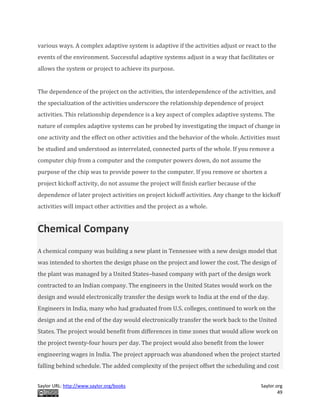





![Saylor URL: http://www.saylor.org/books Saylor.org
55
Complex Systems
Consider the example of the drug manufacturing facility. Describe in your own words
how this project demonstrated the attributes of a complex system.
External
Internal
Technological
Environmental
[1] Stephen Jay Gould, Full House: The Spread of Excellence from Plato to Darwin (New York:
Three Rivers Press, 1996).
2.4 Darnall-Preston Complexity Index Structure
LEARNING OBJECTIVES
1. Describe each of the external attributes that contribute to project complexity.
2. Describe each of the internal attributes that contribute to project complexity.
3. Describe each of the technological attributes that contribute to project complexity.
4. Describe each of the environmental attributes that contribute to project complexity.
The Darnall-Preston Complexity Index (DPCI™) is designed to develop a project profile that
reflects different aspects of the project that will influence the approach to leading and
executing the project. The DPCI is built on four categories of attributes:
1. External. Environmental attributes that are in existence at the beginning of the project,
such as size, duration, and available resources
2. Internal. Clarity of project objectives, the clarity of scope, the organizational complexity,
and stakeholder agreement
3. Technological. Newness of the technology and familiarity of team members with the
technology](https://image.slidesharecdn.com/projectmanagement-fromsimpletocomplex-150108153836-conversion-gate02/85/Project-management-from-simple-to-complex-55-320.jpg)




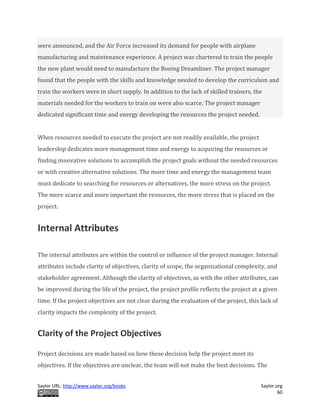




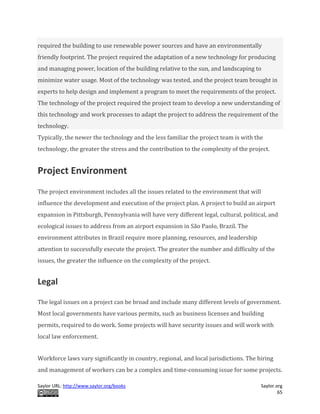





![Saylor URL: http://www.saylor.org/books Saylor.org
71
EXERCISES
1. The external attributes considered in the DPCI are relative size, ________, and
available resources.
2. The internal attributes considered in the DPCI are clarity of scope, complexity of the
organization, and agreement among _________.
3. The technological attributes considered in the DPCI are ______ of the technology and
familiarity of the team with the technology.
4. The environmental attributes considered in the DPCI are _____, cultural, political,
impact on the ecology, and impact of the ecology on the project.
5. Under what circumstances would a large project qualify for a low DPCI score?
6. Describe an organization structure that would receive a high score for complexity.
7. Does the technology attribute refer to the technology used by the project team or the
project itself?
8. Give an example of a cultural problem that would have a high-complexity score.
9. Give an example of an ecological problem that would have a high-complexity score.
10. What is the difference between an external and an internal attribute in the DPCI?
Behind the Scenes
Stanley Portny [1]
advocates that as a project manager, you research the source of a
project to determine who had the original idea by asking questions of your boss,
reading meeting minutes and feasibility studies, and checking other correspondence
and contacts. The purpose of this investigation is to find out who is most likely to
champion the project if you have trouble, who opposed the project, or whose
interests will be harmed by the project. Consider this advice in light of the Darnall-
Preston Complexity Index and answer the following questions:](https://image.slidesharecdn.com/projectmanagement-fromsimpletocomplex-150108153836-conversion-gate02/85/Project-management-from-simple-to-complex-71-320.jpg)
![Saylor URL: http://www.saylor.org/books Saylor.org
72
Is this an external, internal, technological or environmental attribute? Explain your
reasoning and refer to the definitions provided. A case can be made for putting it in
more than one.
What might you find that would increase the project’s complexity and what might you
find out that would reduce the complexity? Provide examples of each.
[1] Stanley E. Portny, Project Management for Dummies, 2nd ed. (Hoboken, NJ: Wiley, 2007).
2.5 Exercises
Exercises at the end of the chapter are designed to strengthen your understanding and
retention of the information recently acquired in the chapter.
ESSAY QUESTIONS
Write several paragraphs to provide more in-depth analysis and consideration when
answering the following questions.
1. Compare the attributes used by the Darnall-Preston Complexity Index and those used
by Youker. Which attributes are used in both typologies? Which attributes are not in
common? If you chose to add one attribute to either typology what would it be?
Explain your answer.
2. Complex systems. A complex system adapts to changes in its external and internal
characteristics. Describe a project with which you are familiar that has experienced
changes in its external or internal characteristics during the life of the project and
describe how the project manager and the management team changed their behavior
to adapt to the new situation or how they failed to adapt and the result of that failure.
3.
DISCUSSION
The exercises in this section are designed to promote exchange of information among
students in the classroom or in an online discussion. The exercises are more open](https://image.slidesharecdn.com/projectmanagement-fromsimpletocomplex-150108153836-conversion-gate02/85/Project-management-from-simple-to-complex-72-320.jpg)


![Saylor URL: http://www.saylor.org/books Saylor.org
75
without delaying the end of the project. For example, it is advantageous for the project to
have the major project stakeholders aligned from the beginning, but sometimes it is
difficult to get the commitment from stakeholders to invest the time and resources to
engage in an alignment process. Sometimes it is only after stakeholders begin observing
progress on a project that the project manager can facilitate the stakeholder alignment
processes.
The knowledge, skills, and experience needed on the project can vary in each phase. During
the early phases of a project, the project leadership needs good conceptual skills, the ability
to build a team, and the experience to build a project roadmap. During project closeout, the
project leadership provides a high degree of motivation and attention to details. On a large
project, lasting two or more years, it is common to see the project management team
change leadership to provide skills that are appropriate to the final phases of the project.
The Project Management Institute [1] identifies four major phases of a project as
characteristics of the project life cycle. These four life-cycle phases are initiation, planning,
execution, and project closeout. The initiation phase, which PMI labels “starting the
project,” includes all the activities necessary to start the project. These activities include
holding the project kickoff meeting, confirming or developing conceptual schedules and
budgets, and acquiring project execution resources such as office space, computers, and
communications equipment.
Planning
The planning phase, which PMI labels “organizing and preparing,” includes the
development of more detailed schedules and a budget. The planning also includes
developing detailed staffing, procurement, and project controls plans. The emphasis of the
planning phase is to develop an understanding of how the project will be executed and a
plan for acquiring the resources needed to execute it. Although much of the planning](https://image.slidesharecdn.com/projectmanagement-fromsimpletocomplex-150108153836-conversion-gate02/85/Project-management-from-simple-to-complex-75-320.jpg)



![Saylor URL: http://www.saylor.org/books Saylor.org
79
6. What are the four phases of a project?
Project Phases
Consider a personal project that you have been involved with in the last few years,
such as moving your residence, buying a car, or changing jobs. Describe the activities
related to that project that fit into each of the four project phases.
[1] Project Management Institute, Inc., A Guide to the Project Management Body of Knowledge
(PMBOK Guide), 4th ed. (Newtown Square, PA: Project Management Institute, Inc., 2008), 11–
16.
3.2 Project Organization
LEARNING OBJECTIVES
1. Identify the various functions represented on a project.
2. Analyze and evaluate the influence of organizational structure on project functions.
3. Design a project organizational chart for various project complexity profiles.
There is no single organizational approach to projects. Each project is organized to
accomplish the work effectively and efficiently. Several factors influence the organizational
approach to execute a project. The complexity profile of a project, the culture of the parent
organization, the preferences of the project manager, the knowledge and skills of the team,
and a parent organization with a project management office are examples of factors that
influence the project’s organization.
In developing the project organizational structure, the project manager considers
thespan of control for each manager. The span of control represents the number of people
reporting to a manager. For example, the project manager does not want all the engineers](https://image.slidesharecdn.com/projectmanagement-fromsimpletocomplex-150108153836-conversion-gate02/85/Project-management-from-simple-to-complex-79-320.jpg)
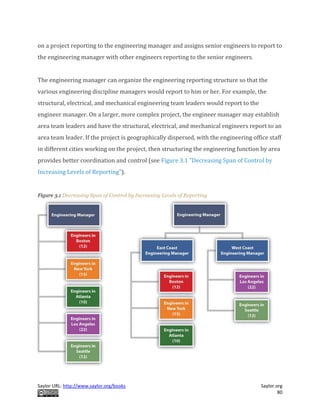






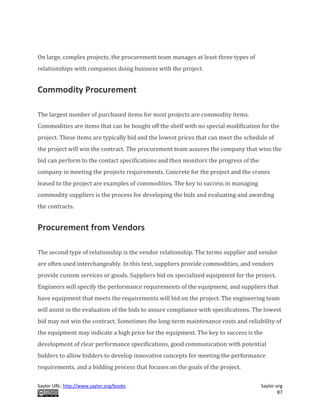

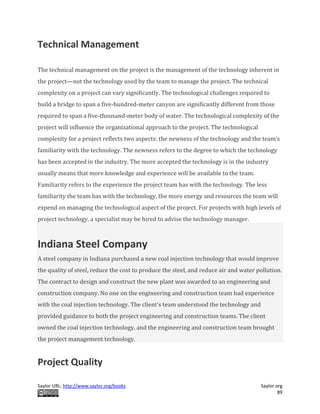











![Saylor URL: http://www.saylor.org/books Saylor.org
101
ESSAY QUESTIONS
Write several paragraphs to provide more in-depth analysis and consideration when
answering the following questions.
1. In June 2009, the CEO of Fiat took on the management of Chrysler and began a project
with the objective of joining the two companies. He chose to “flatten” the
management organization by increasing the number of people who report to him from
a “handful” to twenty-three. Video conferences between the Chrysler and Fiat
management teams take place from a conference room in Chrysler headquarters in
Michigan where there are twenty-three seats and microphones for the Chrysler team
members. [1]
What do you think are the pros and cons of changing the CEO’s span of
control in this manner? Will this increase or decrease the complexity of the
organization? Your answer should display an understanding of span of control and
organizational complexity.
2. The DPCI™ and the Myers-Briggs Type Indicator® (MBTI): The human personality is
more complex than a project; an evaluation system developed by Isabel Myers-Briggs
based on the work of psychologist Carl Jung attempts to provide a simple profile based
on four ranges of personality traits: introverted versus extroverted, intuitive versus
sensing, thinking versus feeling, and judging versus perceiving. How does the Myers-
Briggs profile compare and contrast with using the DPCI to determine the strengths
and challenges of a project?
DISCUSSION
The exercises in this section are designed to promote an exchange of information
among students in the classroom or in an online discussion. The exercises are more
open ended, which means that what you find might be completely different from
what your classmates find, and you can all benefit by sharing what you have learned.](https://image.slidesharecdn.com/projectmanagement-fromsimpletocomplex-150108153836-conversion-gate02/85/Project-management-from-simple-to-complex-101-320.jpg)
![Saylor URL: http://www.saylor.org/books Saylor.org
102
1. Controls and procurement. Under what circumstances would the responsibilities of the
controls manager and the procurement manager overlap? Describe the situation. Your
description should indicate an understanding of the roles and duties of each manager.
Consider the examples provided by your classmates and compare them with your
example to determine if you correctly understand these two roles.
2. Describe the four phases of a project in your own words. Pick a project that would
have a score of 1 on the DCPI in the areas of size, organizational complexity,
technology newness, and technology familiarity. Consider the examples provided by
your classmates and compare them with your example to determine if you correctly
understand how to score a project’s complexity in these areas.
[1] Neal E. Boudette, “Fiat CEO Sets New Tone at Chrysler,” Wall Street Journal, June 19,
2009,http://online.wsj.com/article/SB124537403628329989.html (accessed June 21, 2009).](https://image.slidesharecdn.com/projectmanagement-fromsimpletocomplex-150108153836-conversion-gate02/85/Project-management-from-simple-to-complex-102-320.jpg)
![Saylor URL: http://www.saylor.org/books Saylor.org
103
Chapter 4
Understanding and Meeting Client Expectations
Project management is about managing work processes and leading people. The technical
skills of a project manager—the ability to organize the project and develop a scope, budget,
and schedule—are critical to executing a project that will finish on time, within budget, and
to the project specifications. However, the project will not be a success if the important
stakeholders are unhappy with the results.
Project stakeholders often have a significant role in the success of a project. The ability of
the project manager to understand the expectations of the various stakeholders and
motivate them to contribute to the project success is a major aspect of the project
manager’s leadership role. In this chapter, we explore the concepts and skills needed by the
project manager to understand and meet the expectations of the one of the most important
stakeholders—the client—and the various means and methods for motivating the client to
contribute to project success.
One of the definitions of project success focuses on achieving client satisfaction. This
definition highlights the importance of the client as critical for both defining and achieving
project success. The client is an important project constituent and in most cases the most
important constituent. Darnall [1] described actions for the project manger focused on
defining and meeting client expectations. Project success often includes meeting project
goals and specifications, and it also includes understanding and meeting the expectations of
the client. Depending on the complexity level of the project, the plan to meet the client’s](https://image.slidesharecdn.com/projectmanagement-fromsimpletocomplex-150108153836-conversion-gate02/85/Project-management-from-simple-to-complex-103-320.jpg)
![Saylor URL: http://www.saylor.org/books Saylor.org
104
expectations can range from having a general discussion with the project leadership team
to developing a formal plan that is tracked during the life of the project.
[1] Russell W. Darnall, The World’s Greatest Project (Newtown Square, PA: Project Management
Institute, Inc., 1996), 48–55.
4.1 Including the Client
LEARNING OBJECTIVES
1. Describe what the client needs to know about changes in management style during
different phases of a project.
2. Identify advantages and disadvantages of including the client on project teams.
To appreciate the skill and effort expended by the project team in achieving the objectives
of the project, the client needs to know more about what the team does.
Educate the Client from the Beginning
Often the client does not have the project management experience of the project manager
or project team. An experienced project manager understands the phases of the project and
the requirements of the different phases. A less experienced client may become frustrated
at the changes in the management approach required for the different phases of the
project. For example, during the early phases, the project leadership is encouraging
creative approaches to accomplishing the project goals. As the project proceeds and the
project plan becomes more firm, the project leadership focuses on accomplishing the
project goals. The types of meetings, the agenda of the meetings, and the general project
atmosphere change as the project moves from the planning phase to the production mode
of the execution phase of the project.](https://image.slidesharecdn.com/projectmanagement-fromsimpletocomplex-150108153836-conversion-gate02/85/Project-management-from-simple-to-complex-104-320.jpg)




![Saylor URL: http://www.saylor.org/books Saylor.org
109
After the project team captures the client expectations, the team then develops a method
for tracking performance against expectations. In our example, the project team defined
accuracy and timeliness in measurable terms and tracked the team performance. The
project team developed a survey to track the client’s perception of inclusion in the
problem-solving process and tracked the client’s response. These measures were then
presented in the project review meetings with other measures of project performance such
as cost and schedule.
As the project team meets and exceeds the client expectations, these expectations tend to
change. If the goal is 85 percent accuracy on all project billings, and the project team begins
to perform with an average of 95 percent accuracy or higher and never falls below 90
percent, then the client begins to expect 95 percent accuracy. This is a realistic expectation
of the client; it also changes the expectation so that meeting the client’s expectation
becomes harder. Even if expectations change, it is important to maintain the original goal.
This reminds the client at the end of the project that the project team not only met
expectations but also raised them during the life of the project.
Clarify Values
Values are desirable principles or qualities. [1] Disagreements based on differences in
values are extremely difficult to resolve because compromising means compromising your
values. Organizations often have developed a list of corporate values. Sometimes these are
real and sometimes they are more important to the corporate brand. The project manager
needs to understand the real organizational and personal values related to the project.
On construction projects, safety is an important consideration in the planning and
execution of a project. Every construction company will assert a strong safety value. The
value is tested when safety rules are developed. Is the organization willing to terminate or
sanction an employee for a major safety violation? This is not a yes or no question but the](https://image.slidesharecdn.com/projectmanagement-fromsimpletocomplex-150108153836-conversion-gate02/85/Project-management-from-simple-to-complex-109-320.jpg)

![Saylor URL: http://www.saylor.org/books Saylor.org
111
During the life of the project, the project manager will often have the opportunity to take
advantage of the client, either because a clause in the contract is not written accurately or
because the project manager has access to more detailed information. For example, a client
finds a mistake in the original documents provided to the project team. The project team
analyzes the new information to access the potential impact on the project cost and
schedule. A skilled project manager can demonstrate a negative impact and increase
project profits by requesting a change order. A skilled project manager can also usually find
an innovative approach to finding a solution without increasing the cost or schedule. In
most cases, the client wants to be treated fairly. Fairness is characterized by impartiality
and honesty that is free from self-interest, prejudice, or favoritism. [2] If the client interprets
the change order as fair, then the project manager has the opportunity to create a satisfied
client. If the client believes the behavior of the project manager is unfair, then it is difficult
to create a satisfied client.
KEY TAKEAWAYS
To identify client expectations, review written documents, but have a dialogue with
the client to uncover unwritten expectations by asking questions and listening.
Manage increasing expectations by reminding the client of the original objectives.
Determine the stated corporate values by reviewing written documents and review
actions related to those stated values to see which ones are the basis for action.
Attempt to avoid conflicts of values by identifying the differences before they become
problems.
Do not take advantage of clients’ mistakes, but help them meet their objectives in
spite of their errors. Live your own values of fairness.
EXERCISES
1. If a project is regularly exceeding the stated goal for quality, it is important to remind
the client of the __________ objective.
2. Values are desirable _______ or qualities.](https://image.slidesharecdn.com/projectmanagement-fromsimpletocomplex-150108153836-conversion-gate02/85/Project-management-from-simple-to-complex-111-320.jpg)
![Saylor URL: http://www.saylor.org/books Saylor.org
112
3. Treating a client fairly means avoiding _______, prejudice, or favoritism.
4. What are some written sources of client expectations?
5. What is an example of a corporate value?
6. What does it mean to treat a client fairly?
Organizational Values
Choose an organization with which you are familiar that proclaims to support a
particular set of values. Describe actions that it has taken that either support or differ
from its stated values.
[1] Merriam-Webster Unabridged Online Dictionary, s.v. “values,” http://unabridged.merriam-
webster.com/cgi-bin/collegiate (accessed June 18, 2009).
[2] Merriam-Webster Unabridged Online Dictionary, s.v. “fairness,” http://unabridged.merriam-
webster.com/cgi-bin/collegiate?va=fairness&x=0&y=0 (accessed June 18, 2009).
4.3 Dealing with Problems
LEARNING OBJECTIVES
1. Describe standards and procedures for dealing with problems.
2. Describe the advantages of dealing with difficult issues as soon as they arise.
3. Describe the importance of establishing methods for revising major decisions.
Projects always experience unexpected problems that produce stress. Dealing with
problems with competence is vital to maintaining a good relationship with clients.
Establish Standards and Procedures for Decisions](https://image.slidesharecdn.com/projectmanagement-fromsimpletocomplex-150108153836-conversion-gate02/85/Project-management-from-simple-to-complex-112-320.jpg)








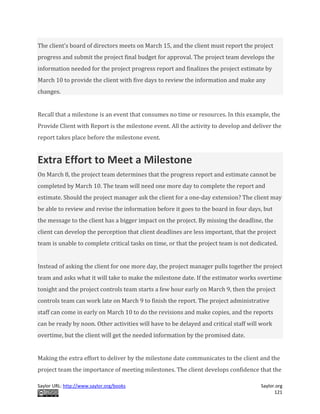







![Saylor URL: http://www.saylor.org/books Saylor.org
129
the project management profession has integrated the two concepts, and project
management refers to the leadership and management needed to lead and manage a
project. A project manager leads people and manages work processes.
Project management is both art and science. It is the art of creating a vision of success,
building a project team, and developing a project story. Project leadership encompasses the
personality, leadership style, and leadership skills of the project manager. Project
management also includes formulas and processes for calculating the critical path,
developing goals, and managing meetings.
Some projects are more leader sensitive, [1] and the success of the project is more
dependent on the leadership skills of the project manager. Leadership is a function of the
project manager’s leadership style, personality type, and understanding of emotions.
Management is mastery of the skills needed to organize and execute the work of the
project. Each project includes challenges that require both leadership and management.
The leadership and management skills needed are related to the project complexity profile.
In general, more complex projects require a greater degree of leadership and management
skill. This chapter will review various leadership approaches and management skills.
[1] Albert A. Einsiedel, “Profile of Effective Project Managers,” Project Management Journal 18
(1987): 5.
5.1 Working with Individuals
LEARNING OBJECTIVES
1. Describe emotional intelligence.
2. Describe personality types and tools used to describe them.
3. Describe the relationship between leadership style and personality types.
4. Describe people skills that are necessary for negotiation and conflict resolution.
5. Describe how work is delegated.](https://image.slidesharecdn.com/projectmanagement-fromsimpletocomplex-150108153836-conversion-gate02/85/Project-management-from-simple-to-complex-129-320.jpg)
![Saylor URL: http://www.saylor.org/books Saylor.org
130
6. Describe individual goals that are related to personality types.
Working with other people involves dealing with them both logically and emotionally. A
successful working relationship between individuals begins with appreciating the
importance of emotions and how they relate to personality types, leadership styles,
negotiations, and setting goals.
Emotional Intelligence
Emotions are neither positive nor negative. Emotions are both a mental and physiological
response to environmental and internal stimuli. Leaders need to understand and value
their emotions to appropriately respond to the client, project team, and project
environment. Daniel Goleman [1] discussed emotional intelligence quotient (EQ) as a factor
more important than IQ in predicting leadership success. According to Robert Cooper and
Ayman Sawaf, “Emotional intelligence is the ability to sense, understand, and effectively
apply the power and acumens of emotions as a source of human energy, information,
connection, and influence.” [2]
Emotional intelligence includes the following:
Self-awareness
Self-regulation
Empathy
Relationship management
Emotions are important to generating energy around a concept, to building commitment to
goals, and to developing high-performing teams. Emotional intelligence is an important
part of the project manager’s ability to build trust among the team members and with the
client. It is an important factor in establishing credibility and an open dialogue with project
stakeholders. Emotional intelligence is a critical ability for project managers, and the more](https://image.slidesharecdn.com/projectmanagement-fromsimpletocomplex-150108153836-conversion-gate02/85/Project-management-from-simple-to-complex-130-320.jpg)



![Saylor URL: http://www.saylor.org/books Saylor.org
134
understand leadership from the perspective of the characteristics of the leader and the
environment of the situation. Robert Tannenbaum and Warren Schmidt [3] described
leaders as either autocratic or democratic. Harold Leavitt [4] described leaders as
pathfinders (visionaries), problem solvers (analytical), or implementers (team oriented).
James MacGregor Burns [5] conceived leaders as either transactional (focused on actions
and decisions) or transformational (focused on the long-term needs of the group and
organization).
Fred Fiedler [6] introduced contingency theory and the ability of leaders to adapt their
leadership approach to the environment. Most leaders have a dominant leadership style
that is most comfortable. For example, most engineers spend years training in analytical
problem solving and often develop an analytical approach to leadership.
A leadership style reflects personal characteristics and life experiences. Although a project
manager’s leadership style may be predominantly a pathfinder (using Leavitt’s taxonomy),
most project managers become problem solvers or implementers when they perceive the
need for these leadership approaches. The leadership approach incorporates the dominant
leadership style and Fiedler’s contingency focus on adapting to the project environment.
No particular leadership approach is specifically appropriate for managing a project. Each
project has a unique set of circumstances because, by definition, projects are unique
endeavors. The leadership approach and the management skills required to be successful
vary depending on the complexity profile of the project. The Project Management Institute
published research that studied project management leadership skills [7] and concluded
that project managers needed good communication skills and the ability to build
harmonious relationships and motivate others. Beyond this broad set of leadership skills,
the successful leadership approach will depend of the profile of the project.](https://image.slidesharecdn.com/projectmanagement-fromsimpletocomplex-150108153836-conversion-gate02/85/Project-management-from-simple-to-complex-134-320.jpg)

![Saylor URL: http://www.saylor.org/books Saylor.org
136
members of the team were from various locations in the United States and Europe. In
addition to the traditional potential for conflict that arises from team members from
different cultures, the design manager and construction manager were responsible for
protecting the interest of their company in the joint venture.
The project manager held two alignment or team-building meetings. The first was a two-
day meeting held at a local resort and included only the members of the project leadership
team. An outside facilitator was hired to facilitate discussion, and the topic of cultural
conflict and organizational goal conflict quickly emerged. The team discussed several
methods for developing understanding and addressing conflicts that would increase the
likelihood of finding mutual agreement.
The second team-building session was a one-day meeting that included the executive
sponsors from the various partners in the joint venture. With the project team aligned, the
project manager was able to develop support for the project’s strategy and commitment
from the executives of the joint venture. In addition to building processes that would
enable the team to address difficult cultural differences, the project manager focused on
building trust with each of the team members. The project manager knew that building
trust with the team was as critical to the success of the project as the technical project
management skills and devoted significant management time to building and maintaining
this trust.
Negotiation and Conflict Resolution
Einsiedel [8] discussed qualities of successful project managers. The project manager must
be perceived to be credible by the project team and key stakeholders. The project manager
can solve problems. A successful project manager has a high degree of tolerance for
ambiguity. On projects, the environment changes frequently, and the project manager must
apply the appropriate leadership approach for each situation.](https://image.slidesharecdn.com/projectmanagement-fromsimpletocomplex-150108153836-conversion-gate02/85/Project-management-from-simple-to-complex-136-320.jpg)
![Saylor URL: http://www.saylor.org/books Saylor.org
137
The successful project manager must have good communication skills. Barry
Posner [9] connected project management skills to solving problems. All project problems
were connected to skills needed by the project manager:
Breakdown in communication represented the lack of communication skills.
Uncommitted team members represented the lack of team-building skills.
Role confusion represented the lack of organizational skills.
The research indicates that project managers need a large numbers of skills. These skills
include administrative skills, organizational skills, and technical skills associated with the
technology of the project. The types of skills and the depth of the skills needed are closely
connected to the complexity profile of the project. Typically on smaller, less complex
projects, project managers need a greater degree of technical skills. On larger, more
complex projects, project managers need more organizational skills to deal with the
complexity. On smaller projects, the project manager is intimately involved in developing
the project schedule, cost estimates, and quality standards. On larger projects, functional
managers are typically responsible for managing these aspects of the project, and the
project manager provides the organizational framework for the work to be successful.
Listening
One of the most important communication skills of the project manager is the ability to
actively listen. Active listening takes focus and practice to become effective. Active listening
is placing yourself in the speaker’s position as much as possible, understanding the
communication from the point of view of the speaker, listening to the body language and
other environmental cues, and striving not just to hear, but to understand.
Active listening enables a project manager to go beyond the basic information that is being
shared and to develop a more complete understanding of the information.](https://image.slidesharecdn.com/projectmanagement-fromsimpletocomplex-150108153836-conversion-gate02/85/Project-management-from-simple-to-complex-137-320.jpg)

![Saylor URL: http://www.saylor.org/books Saylor.org
139
The project manager used the following techniques:
1. Listening intently to the words of the client and observing the client’s body language
2. Nodding and expressing interest in the client without forming rebuttals
3. Providing feedback and asking for clarity while repeating a summary of the information
back to the client
4. Expressing understanding and empathy for the client
The active listening was important to establishing a common understanding from which an
effective project plan could be developed.
Negotiation
Negotiation is a process for developing a mutually acceptable outcome when the desired
outcome for parties in the negotiation is sufficiently different that both cannot achieve the
desired outcome. A project manager will often negotiate with a client, with team members,
with vendors, and with other project stakeholders. A larger and more complex project will
have a large number of stakeholders, often with conflicting desired outcomes. Negotiation
is an important skill in developing support for the project and preventing frustration
among stakeholders, which could delay or cause project failure.
Vijay Verma [10] suggests that negotiations involve four principles:
1. The first principle is to separate people from the problem. If the person is seen as the
problem, then finding a mutually acceptable solution will be difficult. Framing the
discussions in terms of desired outcomes enables the negotiations to focus on finding new
outcomes.](https://image.slidesharecdn.com/projectmanagement-fromsimpletocomplex-150108153836-conversion-gate02/85/Project-management-from-simple-to-complex-139-320.jpg)


![Saylor URL: http://www.saylor.org/books Saylor.org
142
management by the project team, but the relationship could not have been successful
without good faith negotiations.
Conflict Resolution
Conflict on a project is to be expected because of the level of stress, lack of information
during early phases of the project, personal differences, role conflicts, and limited
resources. Although good planning, communication, and team building can reduce the
amount of conflict, conflict will still emerge. How the project manager deals with the
conflict results in the conflict being destructive or an opportunity to build energy,
creativity, and innovation.
David Whetton and Kim Cameron [11] developed a response-to-conflict model that reflected
the importance of the issue balanced against the importance of the relationship. The model
presented five responses to conflict:
1. Avoiding
2. Forcing
3. Collaborating
4. Compromising
5. Accommodating
Each of these approaches can be effective and useful depending on the situation. Project
managers will use each of these conflict resolution approaches depending on the project
manager’s personal approach and an assessment of the situation.
Most project managers have a default approach that has emerged over time and is
comfortable. For example, some project managers find the use of the project manager’s
power the easiest and quickest way to resolve problems. “Do it because I said to” is the](https://image.slidesharecdn.com/projectmanagement-fromsimpletocomplex-150108153836-conversion-gate02/85/Project-management-from-simple-to-complex-142-320.jpg)





![Saylor URL: http://www.saylor.org/books Saylor.org
148
2. A personality assessment tool that is commonly used that identifies preferences
between pairs of terms is the MBTI, or more commonly known as the ________-
________.
3. What is emotional intelligence?
4. What do the letters INTJ stand for in a Myers-Briggs personality profile?
5. How does delegation involve the organization and its people?
Internalize your learning experience by preparing to discuss the following.
Identify which leadership style you think is most suitable for your personality and
which is least suitable. Next, identify a level of project complexity or project phase
where your preferred style is least suitable. Describe an individual goal and how you
might pursue that goal for strengthening your ability to lead on that type of project or
during that phase.
[1] Daniel Goleman, Emotional Intelligence (New York: Bantam Books, 1995).
[2] Robert K. Cooper and Ayman Sawaf, Executive EQ, Emotional Intelligence in Leadership and
Organizations (New York: Perigree Book, 1997), xiii.
[3] Robert Tannenbaum and Warren Schmidt, “How to Choose a Leadership Pattern,” Harvard
Business Review 36 (1958): 95–101.
[4] Harold Leavitt, Corporate Pathfinders (New York: Dow-Jones-Irwin and Penguin Books,
1986).
[5] James MacGregor Burns, Leadership (New York: Harper & Row, 1978).
[6] Fred E. Fiedler, “Validation and Extension of the Contingency Model of Leadership
Effectiveness,”Psychological Bulletin 76, no. 2 (1971): 128–48.
[7] Qian Shi and Jianguo Chen, The Human Side of Project Management: Leadership
Skills (Newtown Square, PA: Project Management Institute, Inc., 2006), 4–11.](https://image.slidesharecdn.com/projectmanagement-fromsimpletocomplex-150108153836-conversion-gate02/85/Project-management-from-simple-to-complex-148-320.jpg)
![Saylor URL: http://www.saylor.org/books Saylor.org
149
[8] Albert A. Einsiedel, “Profile of Effective Project Managers,” Project Management Journal 18
(1987): 5.
[9] Barry Z. Posner, “What It Takes to Be a Good Project Manager,” Project Management
Journal 18 (1987): 32–46.
[10] Vijay K. Verma, Human Resource Skills for the Project Manager (Sylvia, NC: PMI
Publications, 1996), 145–75.
[11] David Whetton and Kim Cameron, Developing Management Skills (Upper Saddle River, NJ:
Pearson Education, 2005).
5.2 Working with Groups and Teams
LEARNING OBJECTIVES
1. Describe the value of trust and how it relates to contracts and complex projects.
2. Identify four types of trust.
3. Describe how a project manager can build trust.
4. Identify three common meeting types and then describe how they differ.
5. Identity types of teams.
6. Describe the HUMM method of measuring project performance.
7. Describe the importance of developing a project story.
A team is a collaboration of people with different personalities that is lead by a person with
a favored leadership style. Managing the interactions of these personalities and styles as a
group is an important aspect of project management.
Trust
Trust is the foundation for all relationships within a project. Without a minimum level of
trust, communication breaks down, and eventually the project suffers in the form of costs
increasing and schedules slipping. Often, when reviewing a project where the performance](https://image.slidesharecdn.com/projectmanagement-fromsimpletocomplex-150108153836-conversion-gate02/85/Project-management-from-simple-to-complex-149-320.jpg)

![Saylor URL: http://www.saylor.org/books Saylor.org
151
Types of Trust
Svenn Lindskold [1] describes four kinds of trust:
1. Objective credibility. A personal characteristic that reflects the truthfulness of an individual
that can be checked against observable facts.
2. Attribution of benevolence. A form of trust that is built on the examination of the person’s
motives and the conclusion that they are not hostile.
3. Nonmanipulative trust. A form of trust that correlates to a person’s self-interest and the
predictability of a person’s behavior in acting consistent in that self-interest.
4. High cost of lying. The type of trust that emerges when persons in authority raise the cost of
lying so high that people will not lie because the penalty will be too high.
Creating Trust
Building trust on a project begins with the project manager. On complex projects, the
assignment of a project manager with a high trust reputation can help establish the trust
level needed. The project manager can also establish the cost of lying in a way that
communicates an expectation and a value for trust on the project. Project managers can
also assure that the official goals (stated goals) and operational goals (goals that are
reinforced) are aligned. The project manager can create an atmosphere where informal
communication is expected and reinforced.
The informal communication is important to establishing personal trust among team
members and with the client. Allotting time during project start-up meetings to allow team
members to develop a personal relationship is important to establishing the team trust.
The informal discussion allows for a deeper understanding of the whole person and creates
an atmosphere where trust can emerge.
High Cost of Lying in a Charleston Project](https://image.slidesharecdn.com/projectmanagement-fromsimpletocomplex-150108153836-conversion-gate02/85/Project-management-from-simple-to-complex-151-320.jpg)





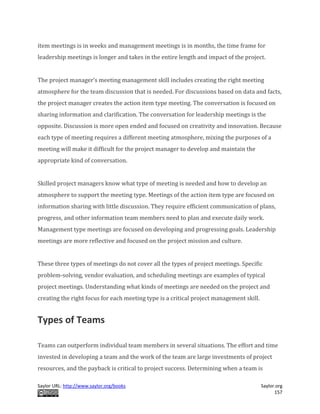
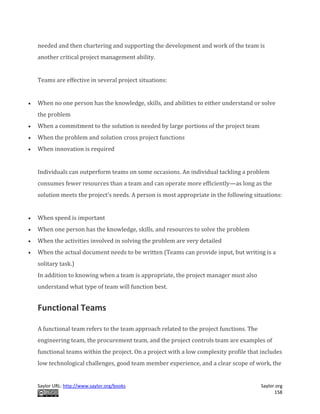

![Saylor URL: http://www.saylor.org/books Saylor.org
160
needed by the project was at risk. A problem-solving team was chartered to assess the
problem and develop a solution for the project. The team brought in some accounting
expertise from the parent company and assessed the status of the vendor. The engineering
team assessed the current state of the design, and the construction team developed an
alternative schedule to allow for a late delivery of the equipment. The team developed a
plan to support the vendor with funds and expertise that allowed the project to complete
on time. The problem-solving team was organized to address a specific problem, developed
and executed a plan to address the problem, and then was disbanded.
Qualitative Assessment of Project Performance
Project managers should provide an opportunity to ask such questions as “What is your gut
feeling about how the project going?” and “How do you think our client perceives the
project?” This creates the opportunity for reflection and dialogue around larger issues on
the project. The project manager creates an atmosphere for the team to go beyond the data
and search for meaning. This type of discussion and reflection is very difficult in the stress
of day-to-day problem solving.
The project manager has several tools for developing good quantitative information—
based on numbers and measurements—such as the project schedules, budgets and budget
reports, risk analysis, and goal tracking. This quantitative information is essential to
understanding the current status and trends on the project. Just as important is the
development of qualitative information—comparisons of qualities—such as judgments
made by expert team members that go beyond the quantitative data provided in a report.
Some would label this the “gut feeling” or intuition of experienced project managers.
The Humm Factor is a tool developed by Russ Darnall [2] to capture the thoughts of project
participants that are not reflected in the project reporting tools. The Humm Factor derived
its name from a project manager who always claimed he could tell you more by listening to](https://image.slidesharecdn.com/projectmanagement-fromsimpletocomplex-150108153836-conversion-gate02/85/Project-management-from-simple-to-complex-160-320.jpg)





![Saylor URL: http://www.saylor.org/books Saylor.org
166
would trust the other to do? What would be an example of a project team function or
type of team where this trust would be beneficial?
[1] Svenn Lindskold, “Trust Development, the GRIT Proposal, and the Effects of Conciliatory Acts
on Conflict and Corporation,” Psychological Bulletin 85, no. 4 (1978): 772–93.
[2] Shari Caudron, “Industry’s Unsung Heroes,” Industry Week, December 4, 1995, 12–16.
5.3 Creating a Project Culture
LEARNING OBJECTIVES
1. Describe how project culture is developed and enforced.
2. Describe how differences in culture between stakeholders can influence the project.
3. Describe the role of innovation on projects.
Project managers have a unique opportunity during the start-up of a project. They create a
project culture, something organizational managers seldom have a chance to do. In most
organizations, the corporate or organizational culture has developed over the life of the
organization, and people associated with the organization understand what is valued, what
has status, and what behaviors are expected. Edgar Schein defined culture as a pattern of
basic assumptions formed by a group on how to perceive and address problems associated
with both internal adaptation and external integration. [1] Schein also described
organizational culture as an abstract concept that constrains, stabilizes, and provides
structure to the organization. At the same time, culture is being constantly enacted, created,
and shaped by leadership behavior.
Characteristics of Project Culture
A project culture represents the shared norms, beliefs, values, and assumptions of the
project team. Understanding the unique aspects of a project culture and developing an](https://image.slidesharecdn.com/projectmanagement-fromsimpletocomplex-150108153836-conversion-gate02/85/Project-management-from-simple-to-complex-166-320.jpg)






![Saylor URL: http://www.saylor.org/books Saylor.org
173
Describe a team project with which you are familiar where the objective was to find
an innovative solution. What was the level of stress and how was it managed to
support an innovative atmosphere?
[1] Edgar Schein, “Organizational Culture,” American Psychologist 45 (1990): 109–19.
5.4 Exercises
Exercises at the end of the chapter are designed to strengthen your understanding and
retention of the information recently acquired in the chapter.
ESSAY QUESTIONS
Write several paragraphs to provide more in-depth analysis and consideration when
answering the following questions.
1. Describe two situations that involve delegating work to other people. The first is a
positive example that worked well, and the other is one that did not. Analyze the
reasons for the success and failure of the two examples using the information about
trust and personality types from this chapter.
2. Choose a project with which you are familiar that does not have a good elevator story.
Attempt to create one and explain how it could be used to promote the project.
DISCUSSION
The exercises in this section are designed to promote exchange of information among
students in the classroom or in an online discussion. The exercises are more open
ended, which means that what you find might be completely different from what your
classmates find, and you can all benefit by sharing what you have learned.
1. Describe a project where trust or distrust became a major factor in the success or
failure of the project. Using the four kinds of trust described by Lindskold, explain how
trust was formed or lost. Consider the descriptions offered by other students of their](https://image.slidesharecdn.com/projectmanagement-fromsimpletocomplex-150108153836-conversion-gate02/85/Project-management-from-simple-to-complex-173-320.jpg)

![Saylor URL: http://www.saylor.org/books Saylor.org
175
3. Identify questions to answer when considering new communications technologies.
Completing a complex project successfully requires good communication among team
members. If those team members work in the same building, they can arrange regular
meetings, simply stop by each other’s office space to get a quick answer, or even discuss a
project informally at other office functions. Many projects are performed by teams that
interact primarily through electronic communication and are, therefore, called called
virtual teams. [1] To avoid miscommunication that can harm trust and to include team
members in a project culture, the project team needs a plan for communicating reliably and
in a timely manner. This planning begins with understanding two major categories of
communication.
Synchronous Communications
If all the parties to the communication are taking part in the exchange at the same time, the
communication is synchronous. A telephone conference call is an example of synchronous
communication. When the participants are not interacting at the same time, the
communication is not synchronous, or asynchronous.
The following are examples of synchronous communications:
Live meeting. Gathering of team members at the same location.
Audio conference. A telephone call between two individuals or a conference call where
several people participate.
Computer-assisted conference. Audio conference with a connection between computers that
can display a document or spreadsheet that can be edited by both parties.
Video conference. Similar to an audio conference but with live images of the participants.
Some laptop computers have built-in cameras to facilitate video conferencing, as shown
in Figure 6.1 "Video Conferencing by Laptop".](https://image.slidesharecdn.com/projectmanagement-fromsimpletocomplex-150108153836-conversion-gate02/85/Project-management-from-simple-to-complex-175-320.jpg)
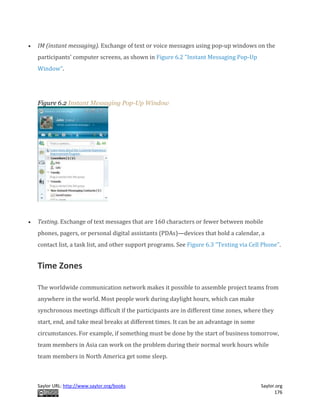





![Saylor URL: http://www.saylor.org/books Saylor.org
182
6. What are two examples of synchronous communications technologies that you
have used?
7. What are two examples of asynchronous communications technologies that you
have used?
8. What is a virtual team?
9. Where is the reference time zone and why is it sometimes referred to as both GMT
and UT?
10. Why are fax machines still used for legal documents?
Internalize your learning experience by preparing to discuss the following.
If you were managing a functional team that included people from three other
countries, which synchronous communications technologies would you include in
your communications plan and for what purposes? Which asynchronous
technologies would you use and for what purposes? What new technologies would
you consider?
[1] Business Dictionary, s.v. “Virtual
Team,” http://www.businessdictionary.com/definition/virtual-team.html (accessed January 27,
2010).
6.2 Selecting Software
LEARNING OBJECTIVES
1. Identify the types of software that are appropriate for projects of low complexity.
2. Identify the types of software that are appropriate for projects of medium complexity.
3. Identify the types of software that are appropriate for projects of high complexity.
4. Describe strategies for sharing documents that can be edited by a team.](https://image.slidesharecdn.com/projectmanagement-fromsimpletocomplex-150108153836-conversion-gate02/85/Project-management-from-simple-to-complex-182-320.jpg)


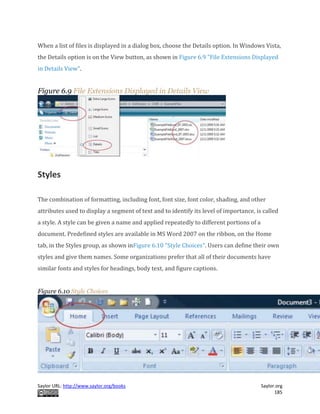


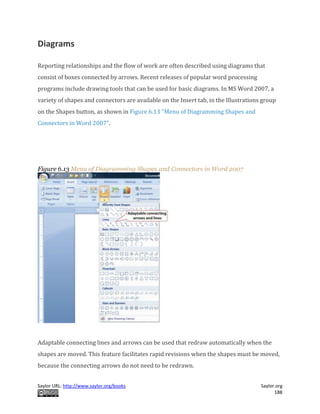



















![Saylor URL: http://www.saylor.org/books Saylor.org
208
Responsibility of the organization toward the stakeholders
Products or services offered
Police Department Mission Statement
The mission of the Philadelphia Police Department is to fight crime and the fear of crime,
including terrorism, by working with our partners to enforce the laws, apprehend
offenders, prevent crime from occurring, and improve the quality of life for all
Philadelphians. [1]
The missions of organizations can be categorized as profit, not for profit, and government.
A business that is created to make a profit for its owners and stock holders must consider
the cost of each project and how much profit it is likely to generate. The mission statement
of a not-for-profit organization like a charity would emphasize the service it provides. A
not-for-profit organization must control its costs so that it does not exceed its funding, and
it is always seeking funding and is in competition with other not-for-profit organizations
for funding from the same sources. A government agency, like a police department, is
similar to a not-for-profit organization, but its sources of funding are usually taxes and fees.
Its mission would include its responsibilities to the citizens it represents. Government
organizations compete for funding from higher levels of government. Projects are more
likely to be funded if the proposal for the project is closely aligned with the mission of the
organization. The project manager must be aware of that mission while building a team and
aligning it behind the purpose of the project.
Goals and Objectives
Senior administrators of the organization decide on how to achieve the mission of the
organization by choosing goals. For example, the director of a not-for-profit preschool that
provides low-cost education for children of poor, single parents might set a goal of
improving its reputation for quality. A goal is an end toward which effort is directed. The](https://image.slidesharecdn.com/projectmanagement-fromsimpletocomplex-150108153836-conversion-gate02/85/Project-management-from-simple-to-complex-208-320.jpg)








![Saylor URL: http://www.saylor.org/books Saylor.org
217
9. The group that determines the need for a project is the ________ organization.
10. What are four parts of a well-written mission statement?
11. What is the primary mission of each of the following types of organizations: profit-
making, not-for-profit, and government organizations?
12. What does it mean if the money spent on a project has a simple payback of five years?
13. Why is it important to identify project champions?
14. What is an example of funding for a project that is only available for a short period of
time under special circumstances?
Internalize your learning experience by preparing to discuss the following.
Choose an example from outside the assigned reading of a mission, goal, and objective
that demonstrates the characteristics of each and how they relate to each other. The
example can be from a real organization or it can be fictional. Describe the
characteristics of a mission, goal, and objective, as defined in this chapter, and how
the example demonstrates those characteristics.
[1] Philadelphia Police Department, Philadelphia Police Department: Mission Statement,
2009,http://www.ppdonline.org/hq_mission.php (accessed July 16, 2009).
7.2 Project Scope
LEARNING OBJECTIVES
1. Define scope and describe how it is affected by project complexity.
2. Identify the uses of a scope document.
3. Describe how a scope document is developed and changed.
The project scope identifies the total work of the project.
Definition of Scope and the Effects of Complexity](https://image.slidesharecdn.com/projectmanagement-fromsimpletocomplex-150108153836-conversion-gate02/85/Project-management-from-simple-to-complex-217-320.jpg)



![Saylor URL: http://www.saylor.org/books Saylor.org
221
Truck Crash Causes a Deviation to the Schedule
Installation of a fence around the project site was delayed when the truck delivering the
fence was wrecked on the way to the job site. The fence project was delayed by one week
and the delay did not affect any other activity on the project. This deviation from the
original schedule did not cause a delay in the project, and the schedule was adjusted as a
deviation to the schedule—not a change request.
Documenting Changes
It is important to have a written record of changes to the scope of a project. On the least
complex projects, an e-mail message can be sufficient, but on larger projects a standard
form is normally used. The following steps are paraphrased by Tom Mochal, [1] and they
have the necessary components of a change documentation process:
Inform project stakeholders of the change request process.
Require that the change request is made in writing, including the business value of the
change to the project.
Enter the request in the scope change log.
Estimate the time needed to evaluate the change. If the evaluation process is time
consuming and would affect activity completion dates by diverting management resources,
get approval from the project sponsor to evaluate the change request. If the evaluation is
not approved, record the decision in the scope change log.
Evaluate the change and its impact on the schedule and budget if the evaluation is
approved.
Present the change request to the project sponsor for approval. Record the decision in the
scope change log with the recommended course of action.
Distribute the scope change log periodically to team members so they know what changes
are being considered and what happened to those that were not approved or evaluated.](https://image.slidesharecdn.com/projectmanagement-fromsimpletocomplex-150108153836-conversion-gate02/85/Project-management-from-simple-to-complex-221-320.jpg)
![Saylor URL: http://www.saylor.org/books Saylor.org
222
If the change is approved, update the project charter or other initiation documents.
Update the work plan.
Distribute the revised work plan to stakeholders and team members.
KEY TAKEAWAYS
Scope is a description of the major tasks that are included in the project and some of
the tasks that are specifically not included. More complex projects require more
detailed and specific scope documents.
A scope document is used to provide the project team with the information it needs to
design and implement the project plan. It provides understanding of the purpose of
the project and what project success would be.
The scope document begins as a draft that is circulated for comments by the team,
client, and in some cases, key vendors. The final draft is approved by the client or
sponsor. Changes to the scope are documented carefully using standard forms and
processes and approved by the project sponsor or client.
EXERCISES
1. How is the scope statement affected by the complexity of the project?
2. What negative aspect of the scope statement is important?
3. What are the uses of a scope statement?
4. Once a scope statement is agreed to, how is it changed and what is always required
when a scope statement is changed?
Internalize your learning experience by preparing to discuss the following.
Describe a situation where the elements of the project scope did not specifically
exclude an activity that caused a misunderstanding.
[1] Tom Mochal and Jeff Mochal, Lessons in Project Management (Berkeley, CA: Apress, 2003).](https://image.slidesharecdn.com/projectmanagement-fromsimpletocomplex-150108153836-conversion-gate02/85/Project-management-from-simple-to-complex-222-320.jpg)









![Saylor URL: http://www.saylor.org/books Saylor.org
232
Trust on a project has a very specific meaning. Trust is the filter that project team members
use for evaluating information. The trust level determines the amount of information that is
shared and the quality of that information. When a person’s trust in another person on the
project is low, he or she will doubt information received from that person and might not act
on it without checking it with another source, thereby delaying the action. Similarly, a team
member might not share information that is necessary to the other person’s function if they
do not trust the person to use it appropriately and respect the sensitivity of that
information. The level of communication on a project is directly related to the level of trust.
Trust is also an important ingredient of commitment. Team member’s trust in the project
leadership and the creation of a positive project environment fosters commitment to the
goals of the project and increases team performance. When trust is not present, time and
energy is invested in checking information or finding information. This energy could be
better focused on goals with a higher level of trust. [1]
Establishing trust starts during the initiation phase of the project. The kickoff meeting is
one opportunity to begin establishing trust among the project team members. Many
projects have team-building exercises during the kickoff meeting. The project team on
some complex projects will go on a team-building outing. One project that built a new
pharmaceutical plant in Puerto Rico invited team members to spend the weekend
spelunking in the lime caves of Puerto Rico. Another project chartered a boat for an
evening cruise off the coast of Charleston, South Carolina. These informal social events
allow team members to build a relationship that will carry over to the project work.
KEY TAKEAWAYS
The purpose of the alignment process is to develop a common understanding of the
purpose, agree on the means and methods, and establish trust.](https://image.slidesharecdn.com/projectmanagement-fromsimpletocomplex-150108153836-conversion-gate02/85/Project-management-from-simple-to-complex-232-320.jpg)
![Saylor URL: http://www.saylor.org/books Saylor.org
233
The components of the alignment process are discussions of the purpose, goals,
participant roles, methods of tracking progress and costs, methods of managing
change, and building trust.
The effects of a lack of trust are delays caused by fact checking or missing information
that was not shared because the person’s discretion was not trusted to handle
sensitive information.
EXERCISES
1. The initial meeting that is designed to build understanding and consensus around the
goals and objectives of the project is the __________ meeting.
2. What are the objectives of the alignment process?
3. What are five of the seven components of the alignment process?
4. How can lack of trust between team members adversely affect the project?
Internalize your learning experience by preparing to discuss the following.
Why is an alignment meeting important? What needs to be accomplished, and what
are two examples of things that could go wrong if the alignment meeting does not
meet its objectives?
[1] Marsha Willard, “Building Trust: The Relationship Between Trust and High
Performance,” Axis Advisory1999, http://www.paclink.com/~axis/M7trust.html.
7.5 Communications Planning
LEARNING OBJECTIVES
1. Describe the differences between communications in an existing organization
compared with a new project.
2. Describe how the detail of the communications plan is related to the complexity of the
project.
3. Describe a communication matrix and its function.](https://image.slidesharecdn.com/projectmanagement-fromsimpletocomplex-150108153836-conversion-gate02/85/Project-management-from-simple-to-complex-233-320.jpg)







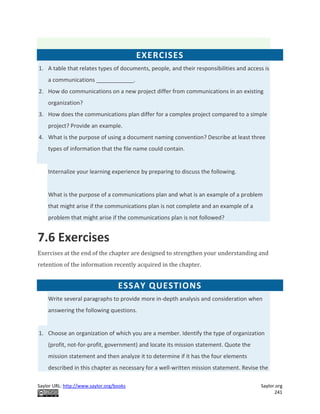




![Saylor URL: http://www.saylor.org/books Saylor.org
246
3. How does a conceptual schedule differ from a master schedule?
Conceptual Schedule
Choose an activity that you are considering and describe a conceptual schedule for
it. Limit the schedule to between five and ten major sections. Make a rough
estimate of the duration and cost of each phase.
8.2 Elements of Time Management
LEARNING OBJECTIVES
1. Describe a work breakdown structure and how it relates to activities.
2. Describe the use of graphic representations for time management.
According to the Project Management Institute (PMI), project time management includes
the following elements: [1]
Define activities
Sequence activities
Estimate activity resources
Estimate activity durations
Develop schedule
Control schedule
The list of activities, their relationship to each other, and estimates of durations and
required resources comprise the work breakdown structure (WBS). The project WBS is
a hierarchical—classified according to criteria into successive levels—listing and grouping
of the project activities required to produce the deliverables of the project. The WBS
represents a breakdown of the project into components that encompass the entire scope of
the project. Each level of the WBS hierarchy represents a more detailed description of the](https://image.slidesharecdn.com/projectmanagement-fromsimpletocomplex-150108153836-conversion-gate02/85/Project-management-from-simple-to-complex-246-320.jpg)





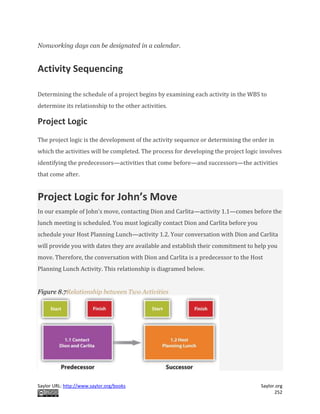





![Saylor URL: http://www.saylor.org/books Saylor.org
258
In our John’s move project, we might create a milestone called “all packing complete” to
represent the date when everything is packed and ready for the moving van. Any delay in
this date will mean a delay in the arrival of the moving van in Chicago, a delay in the arrival
of the moving van in Atlanta, and a delay of all the unpacking and other downstream
activities. See Figure 8.13 "Gantt Chart".
Graphic Representations
Relationships between activities are easier to recognize if they are presented using
graphics such as bar charts or a network of connected boxes.
Bar Charts
The type of bar chart used to illustrate activity relationships in a project is the Gantt chart.
The Gantt chart was developed by Henry Gantt and used on major projects, including
building the Hoover Dam and the U.S. interstate highway system. [2] The Gantt chart, also
called a bar chart, is a time-scaled graphic that represents each activity with a bar that
reflects the duration, start, and finish time, as shown in Figure 8.13 "Gantt Chart".
Figure 8.13 Gantt Chart](https://image.slidesharecdn.com/projectmanagement-fromsimpletocomplex-150108153836-conversion-gate02/85/Project-management-from-simple-to-complex-258-320.jpg)

![Saylor URL: http://www.saylor.org/books Saylor.org
260
The work breakdown structure is a list of activities, including estimates of their
durations, their relationships with others, and the resources assigned to them.
Bar charts are used to indicate durations and sequencing where the relationships are
simple. Network diagrams are used to show complex relationships between activities.
EXERCISES
1. What is work breakdown structure?
2. If two activities are concurrent and they have the same completion date, they have a
_______-_______ relationship.
3. A calendar that shows when a person, facility, or key piece of equipment is available is
a __________ calendar.
4. What is the advantage of a network diagram over a bar chart for illustrating the critical
path?
Compare Charts
Perceptions of graphic representations of data differ among individuals. Consider the
bar chart and network diagram in this section. Describe which type of chart conveys
the important aspects of the project best to you personally and why you think that is
the case. Alternatively, describe which aspects of the project are conveyed to you best
by which type of chart.
[1] Project Management Institute, Inc., A Guide to the Project Management Body of Knowledge
(PMBOK Guide), 4th ed. (Newtown Square, PA: Project Management Institute, Inc., 2008), 129.
[2] Reference.com, “Henry
Gantt,” http://www.reference.com/browse/wiki/Henry_Gantt (accessed July 27, 2009).
8.3 Critical Path and Float](https://image.slidesharecdn.com/projectmanagement-fromsimpletocomplex-150108153836-conversion-gate02/85/Project-management-from-simple-to-complex-260-320.jpg)

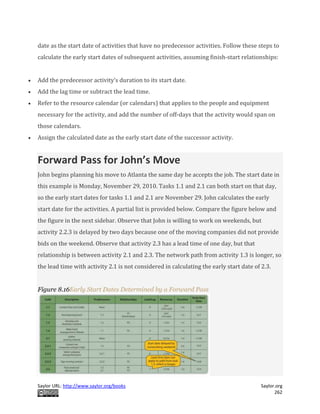





![Saylor URL: http://www.saylor.org/books Saylor.org
268
measure may be lines of code written. The unit of measure that is chosen can affect the
quality of the work.
Units of Measure on a Programming Project
Steve Ballmer of Microsoft recalls early clashes with IBM over the unit of measure used to
determine how much Microsoft would get paid for its work.
In IBM there’s a religion in software that says you have to count K-LOCs, and a K-LOC is a
thousand lines of code. How big a project is it? Oh, it’s sort of a 10 K-LOC project. This is a
20 K-LOCer. And this is 50 K-LOCs. And IBM wanted to sort of make it the religion about
how we got paid. How much money we made off OS/2, how much they did. How many K-
LOCs did you do? And we kept trying to convince them—hey, if we have—a developer’s got
a good idea and he can get something done in 4 K-LOCs instead of 20 K-LOCs, should we
make less money? Because he’s made something smaller and faster, less KLOC. K-LOCs, K-
LOCs, that’s the methodology. Ugh anyway, that always makes my back just crinkle up at
the thought of the whole thing. [1]
In this case, IBM’s insistence on using thousands of lines of code as the unit of measure did
not reward Microsoft for writing smaller code that would run faster. Microsoft and IBM
cancelled their joint project for writing an operating system named OS/2. Microsoft wrote
Windows, and IBM’s OS/2 operating system was not able to compete with it successfully.
On a construction project, a unit of measure may be yards of concrete poured, and on a
training project, the unit of measure may be the class curriculums developed or the
students taught.
Managing Schedules Using Milestones
Milestones provide the opportunity for project management to focus on completing
activities that will have the greatest impact on the schedule. On complex projects, focusing](https://image.slidesharecdn.com/projectmanagement-fromsimpletocomplex-150108153836-conversion-gate02/85/Project-management-from-simple-to-complex-268-320.jpg)





![Saylor URL: http://www.saylor.org/books Saylor.org
274
Progress Reports
From the client’s point of view, describe what you think would be the advantages of
each type of progress measurement.
[1] Robert X. Cringely, Triumph of the Nerds, June
1996, http://www.pbs.org/nerds/part2.html (accessed July 27, 2009).
8.5 Project Scheduling Software
LEARNING OBJECTIVES
1. Describe the relationship between the choice of software and project complexity.
2. Identify the features that should be considered when selecting software for project
management.
Low-complexity projects can be managed with lists of activities on paper or by using an
outline in word processing or spreadsheet software. This software is inadequate for
tracking complex projects. Fortunately, there are several dedicated software programs that
keep track of the complex relationships between activities and resources.
Appropriate to Project Complexity
Simple projects can be tracked using general purpose word processing and spreadsheet
software like those available in Microsoft Office or OpenOffice. Medium-complexity projects
benefit from dedicated project management software such as Microsoft Project and
OpenProject. Complex projects require software that can track the interactions of
thousands of tasks and produce sophisticated reports such as Oracle’s P6.
Features](https://image.slidesharecdn.com/projectmanagement-fromsimpletocomplex-150108153836-conversion-gate02/85/Project-management-from-simple-to-complex-274-320.jpg)







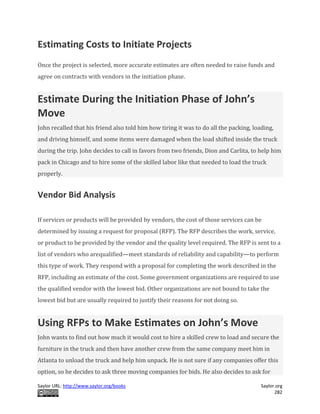



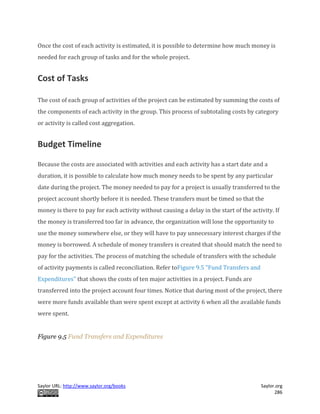



![Saylor URL: http://www.saylor.org/books Saylor.org
290
Instead of overestimating each cost, money is budgeted for dealing with unplanned but statistically
predictable cost increases. Funds allocated for this purpose are
called contingency reserves. [1]Because it is likely that this money will be spent, it is part of the total
budget for the project. If this fund is adequate to meet the unplanned expenses, then the project will
complete within the budget.
Management Reserves
If something occurs during the project that requires a change in the project scope, money
may be needed to deal with the situation before a change in scope can be negotiated with
the project sponsor or client. It could be an opportunity as well as a challenge. Money can
be made available to the project to be used at the discretion of the manager to meet needs
that would change the scope of the project. These funds are called management reserves.
Unlike contingency reserves, they are not likely to be spent and are not part of the project’s
budget baseline, but they can be included in the total project budget. [2]
Evaluating the Budget During the Project
A project manager must regularly compare the amount of money spent with the budgeted
amount and report this information to managers and stakeholders. It is necessary to
establish an understanding of how this progress will be measured and reported.
Reporting Budget Progress on John’s Move
In the John’s move example, he estimated that the move would cost about $1,500 and take
about sixteen days. Eight days into the project, John has spent $300. John tells his friends
that the project is going well because he is halfway through the project but has only spent a
fifth of his budget. John’s friend Carlita points out that his report is not sufficient because
he did not compare the amount spent to the budgeted amount for the activities that should
be done by the eighth day.](https://image.slidesharecdn.com/projectmanagement-fromsimpletocomplex-150108153836-conversion-gate02/85/Project-management-from-simple-to-complex-290-320.jpg)









![Saylor URL: http://www.saylor.org/books Saylor.org
300
cost variances, the ETC is adjusted by dividing the difference between BAC and EV by
the CPI.
The final budget is the actual cost (AC) to this point plus the estimate to complete
(ETC).
EXERCISES
1. Money that is allocated for dealing with unplanned but predictable expenses is
_________ reserve.
2. The formula used to calculate the cost performance index is ____________.
3. The formula used to calculate the estimate to complete for atypical cost variances is
_________________________.
4. The sum of the budgeted amounts for the tasks that have been performed is the
_______ _______ (two words).
5. Schedule variance is the ____ minus the _____ and cost variance is the ____ minus the
_____ (use acronyms).
6. Schedule performance index is ____ / _____ and the cost performance index is _____
/ ______ (use acronyms).
7. The revised final budget is the ____ plus the _____ (use acronyms).
Estimating Earned Value
Consider a project you are familiar with in which the contractor or service provider
who was performing the work needed to be replaced before the job was completed.
Describe how the value of the contractor’s efforts up to that point was determined
and how that evaluation compared to an earned value analysis.
[1] Project Management Institute, Inc., A Guide to the Project Management Body of Knowledge
(PMBOK Guide), 4th ed. (Newtown Square, PA: Project Management Institute, Inc., 2008), 173.](https://image.slidesharecdn.com/projectmanagement-fromsimpletocomplex-150108153836-conversion-gate02/85/Project-management-from-simple-to-complex-300-320.jpg)
![Saylor URL: http://www.saylor.org/books Saylor.org
301
[2] Project Management Institute, Inc., A Guide to the Project Management Body of Knowledge
(PMBOK Guide), 4th ed. (Newtown Square, PA: Project Management Institute, Inc., 2008), 177.
9.3 Exercises
Exercises at the end of the chapter are designed to strengthen your understanding and
retention of the information recently acquired in the chapter.
SHORT ANSWER QUESTIONS
The questions in this section refer to the project budget shown below.
Figure 9.10Example for Short Answer Questions
This project has three completed activities whose durations are indicated by the blue
bars in row 2. The budgeted cost of work scheduled for each task is shown on the bar
in row 2. The budgeted cost of work scheduled for each week is shown on row 3. Notice
that the amounts in row 3 add up to the amounts shown on the bars. Rows 4 and 5
indicate the budgeted cost of work performed and actual cost. Notice that the second
task started a week late.
1. What is the planned value (PV) at the end of week three?
2. What is the earned value (EV) at the end of week three?](https://image.slidesharecdn.com/projectmanagement-fromsimpletocomplex-150108153836-conversion-gate02/85/Project-management-from-simple-to-complex-301-320.jpg)

![Saylor URL: http://www.saylor.org/books Saylor.org
303
DISCUSSION
The exercises in this section are designed to promote exchange of information among
students in the classroom or in an online discussion. The exercises are more open
ended, which means that what you find might be completely different from what your
classmates find, and you can all benefit by sharing what you have learned.
1. Describe an experience of your own that involved a parametric estimate. Describe the
parameter and how it was used. Compare the estimate with the actual cost.
2. As an inexperienced project manager, how do you develop expert knowledge?
Interview someone who would qualify as an expert in estimating costs and ask them
to describe the process they went through. Ask them for advice on how to become an
acknowledged expert in estimating and then share what you learn with your
classmates.
10.1 Quality and Statistics
LEARNING OBJECTIVES
1. Define quality.
2. Define and explain statistics terms used in quality control.
3. Estimate the likelihood of samples falling within one, two, or three standard
deviations of the mean given a normal distribution caused by random factors.
Definitions of Quality and Grade
Quality is a relative term, which means that something is of high or low quality compared
to what it is required to be. According to the International Organization for Standardization
(ISO), quality is “the degree to which a set of inherent characteristics fulfill
requirements.” [1] The requirements of a product or process can be categorized or given](https://image.slidesharecdn.com/projectmanagement-fromsimpletocomplex-150108153836-conversion-gate02/85/Project-management-from-simple-to-complex-303-320.jpg)








![Saylor URL: http://www.saylor.org/books Saylor.org
312
5. If the measurements in a frequency distribution chart are grouped near the mean in
normal distribution, what does that imply about the causes of the variation?
6. If you have a set of sample data and you had to calculate the standard deviation, what
are the steps?
7. If a set of sample measurements has a mean of 100, a normal distribution, a standard
deviation of 2, and control limits of 94 and 106, what percentage of the samples are
expected to be between 94 and 106? Explain your answer.
Using Statistical Measures
Choose two groups of people or items that have a measurable characteristic that can
be compared, such as the height of adult males and females. Describe the distribution
of the measurements by stating whether you think the groups have a relatively small
or large standard deviation and whether the distributions overlap (e.g., some women
are taller than some men even though the mean height for men is greater than the
mean height for women). Demonstrate that you know how to use the following terms
correctly in context:
Normal distribution
Standard deviation
Mean
[1] International Organization for Standardization, Quality Management Systems—
Fundamentals and Vocabulary (Geneva: ISO Press, 2005), in Project Management Institute,
Inc., A Guide to the Project Management Body of Knowledge (PMBOK Guide), 4th ed. (Newtown
Square, PA: Project Management Institute, Inc., 2008), 190.
10.2 Development of Quality as a
Competitive Advantage
LEARNING OBJECTIVES](https://image.slidesharecdn.com/projectmanagement-fromsimpletocomplex-150108153836-conversion-gate02/85/Project-management-from-simple-to-complex-312-320.jpg)
![Saylor URL: http://www.saylor.org/books Saylor.org
313
1. Describe the historical events and forces that led up to today’s emphasis on quality as
a competitive requirement.
2. Describe quality awards in Japan and the United States.
3. Describe quality programs and standards such as TQM, Six Sigma, and ISO 9000.
4. Describe and calculate the cost of quality.
Quality management is an approach to work that has become increasingly important as
global cooperation and competition have increased. A review of the history of quality
management explains why it is so important to companies and why clients often require
projects to document their processes to satisfy quality standards.
Statistical Control Before World War II
Prior to the late 1700s, products such as firearms and clocks were made as individual
works where the parts were adjusted to each other so they could work together. If a part
broke, a new one had to be made by hand to fit. In 1790 in France, Honoré Blanc
demonstrated that he could make musket parts so nearly identical that a musket could be
assembled from bins of parts chosen at random. [1] The practice of making parts to a high
level of accuracy in their dimensions and finishes made the parts interchangeable. The use
of interchangeable parts became the founding principle of assembly line manufacturing to
produce all manner of goods from sewing machines to automobiles. The manufacturers of
firearms and weapons were often the leaders in improving quality because reliable and
safe operation of weapons and their rapid repair is a matter of life and death.
Statistical Control in the United States During World
War II](https://image.slidesharecdn.com/projectmanagement-fromsimpletocomplex-150108153836-conversion-gate02/85/Project-management-from-simple-to-complex-313-320.jpg)


![Saylor URL: http://www.saylor.org/books Saylor.org
316
The most influential person in modern quality control was an American who was a hero in
Japan but virtually unknown in the United States. W. Edwards Deming worked with
Shewhart at Bell Labs and helped apply Shewhart’s ideas to American manufacturing
processes during World War II. Following the war, American factories returned to the
production of consumer goods. Many of the other major manufacturing centers in the
world had been damaged by bombing during the war and took time to recover. Without the
safety needs of wartime and with little competition, quality control was not a high priority
for American companies. [2] Management in the United States focused on increasing
production to meet demand and lowering costs to increase profits.
After the war, while the United States occupied Japan, Deming was asked by the U.S.
Department of the Army to assist with the statistics of the 1950 census in Japan. Kenichi
Koyanagi, the managing director of the Union of Japanese Scientists and Engineers and a
very influential industrialist, asked Deming to speak to twenty-one top industrial leaders
on the topic of global strategy for Japanese industry. Deming went beyond Shewhart’s work
and talked about his philosophy of quality manufacturing and how the responsibility for
quality begins with management. He explained that a corporate culture devoted to
producing high-quality products would result in less waste, lower costs, greater client
loyalty, and greater market share. With Koyanagi’s support, Deming’s ideas were widely
adopted by these influential leaders.
Deming described his philosophy as a system of profound knowledge, which has four parts:
1. Appreciation of a system. Understanding how suppliers, producers, and clients interact
2. Knowledge of variation. Understanding statistical variation
3. Theory of knowledge. Understanding what can be known and what cannot
4. Knowledge of psychology. Understanding human nature](https://image.slidesharecdn.com/projectmanagement-fromsimpletocomplex-150108153836-conversion-gate02/85/Project-management-from-simple-to-complex-316-320.jpg)
![Saylor URL: http://www.saylor.org/books Saylor.org
317
In 1950, the Japanese created the Deming prize in Deming’s honor, which is awarded to an
individual and a company for major advances in quality improvements. In 1960, Deming
was awarded the Order of the Sacred Treasure, Second Class by the Prime Minister on
behalf of Emperor Hirohito.
Quality Management in America
By the 1970s, Japanese companies had a reputation for high quality and were taking
market share from American companies, but Deming’s teachings were virtually unknown
in his own country. It was not until 1980 that America became aware of Deming when his
work was described in an NBC documentary titled If Japan Can, Why Can’t We? [3] By then,
Deming was eighty years old and the producer of the show originally assumed he was
dead. [4]
In 1982, Deming’s book was published and later retitled Out of Crisis, in 1986. [5] It was
aimed at explaining his system to American manufacturers and the American public. In the
book, Deming described fourteen principles of management to guide the implementation of
his philosophy. Some of them were challenges to Western managers and very different
from the thinking that was prevalent at the time. In brief, they are as follows:
1. Create constancy of purpose toward improvement of product and service.
2. Adopt a new philosophy. We are in a new economic age. Western management must
awaken to the challenge, learn their responsibilities, and take on leadership for a change.
3. Cease dependence on inspection to achieve quality. Eliminate the need for inspection on a
mass basis by building quality into the product in the first place.
4. End the practice of awarding business on the basis of price tag. Instead, minimize cost.
Move toward a single supplier for any one item, on a long-term relationship of loyalty and
trust.](https://image.slidesharecdn.com/projectmanagement-fromsimpletocomplex-150108153836-conversion-gate02/85/Project-management-from-simple-to-complex-317-320.jpg)
![Saylor URL: http://www.saylor.org/books Saylor.org
318
5. Improve constantly and forever the system of production and service to improve quality
and productivity and thus constantly decrease costs.
6. Institute training on the job.
7. Institute leadership. The aim of supervision should be to help people and machines and
gadgets to do a better job. Supervision of management is in need of overhaul, as well as
supervision of production workers.
8. Drive out fear, so that everyone may work effectively for the company.
9. Break down barriers between departments.
10. Eliminate slogans, exhortations, and targets for the workforce asking for zero defects and
new levels of productivity.
11. Eliminate work standards (quotas) on the factory floor. Substitute leadership.
12. Remove barriers that rob the hourly worker of his right to pride of workmanship.
13. Institute a vigorous program of education and self-improvement.
14. Put everybody in the company to work to accomplish the transformation. The
transformation is everybody’s job.
Between 1979 and 1982, Ford Motor Company lost $3 billion, and they were looking for
solutions to their problems. They chose to apply Deming’s approach to develop the new
Taurus-Sable model and by 1986 had become the most profitable American auto
company. [6]
Ford adopted a Japanese approach to quality known in America
astotal quality management (TQM). TQM in Japan has four major components:
1. Kaizen. Improvement must involve all members of a company. [7]
2. Atarimae hinshitsu. Make things work the way they are supposed to work. [8]
3. Kansei. Learn from the way a user applies the product to make improvements. [9]
4. Miryokuteki hinshitsu. Things should have an aesthetic quality and be pleasing to use. [10]
According to Peter B. Petersen, [11] TQM differs from the Deming approach in four
fundamental ways:](https://image.slidesharecdn.com/projectmanagement-fromsimpletocomplex-150108153836-conversion-gate02/85/Project-management-from-simple-to-complex-318-320.jpg)

![Saylor URL: http://www.saylor.org/books Saylor.org
320
Cost of failure
a. Internal costs. Repairing bad parts before shipment or retooling a manufacturing
line to reduce failures
b. External costs. Managing returns, lawsuits, product recalls
Six Sigma identified individuals as experts in quality and awarded titles like Champion and
Master Black Belt. The name Six Sigma refers to a process that has six standard deviations
from the mean to either control limit that would ensure virtually zero defects. (In practice,
the Six Sigma approach allows for a 1.5 sigma drift, so it is really a 4.5 sigma standard that
allows approximately 3.4 defects per million products.) This approach was adopted by Jack
Welch at General Electric with great success. By the late 1990s, about two-thirds of the top
five hundred companies in the United States had begun Six Sigma projects, including Ford,
which had allowed its quality programs to slip. To provide encouragement and a consistent
standard, the U.S. government created the Malcolm Baldrige National Quality Award in
1987 to encourage companies to improve quality; the award was named for Malcolm
Baldrige who was the U.S. secretary of commerce from 1981 to 1987. [12] The criteria used
to determine award winners are as follows:
1. Leadership of senior executives
2. Strategic planning
3. Customer and market focus
4. Measurement, analysis, and knowledge management
5. Workforce focus
6. Process management
7. Results
Trade and International Standards](https://image.slidesharecdn.com/projectmanagement-fromsimpletocomplex-150108153836-conversion-gate02/85/Project-management-from-simple-to-complex-320-320.jpg)
![Saylor URL: http://www.saylor.org/books Saylor.org
321
Trade between countries increased as countries recovered from WWII and began
producing consumer goods. In 1948, the General Agreement on Tariffs and Trade (GATT)
established the rules for international trade in the postwar world. Through years of
negotiations based on GATT, the World Trade Organization (WTO) was created in 1995.
The WTO is a negotiating forum where governments can discuss ways to help trade flow as
freely as possible. [13]
Increases in trade forced companies to improve the quality of their products to compete for
clients and to exchange parts reliably between companies that used parts suppliers. To
assist in developing standards for quality that would be the same between countries, an
organization of 158 national standards groups formed
theInternational Organization for Standardization (ISO), which is headquartered in
Switzerland. For example, a company might require a parts supplier to meet certain ISO
standards if it wants to bid on contracts. There are thousands of ISO standards, and they
are grouped by their numbers. The ISO 9000 group of standards relate to quality:
ISO 9000. Fundamentals and vocabulary for this group of quality standards.
ISO 9001. Standards for evaluating the quality management processes in an organization. It
has five parts:
a. Overall requirements for the quality management system and documentation
b. Management responsibility, focus, policy, planning and objectives
c. Resource management and allocation
d. Product realization and process management
e. Measurement, monitoring, analysis, and improvement
ISO 9004. Ways to extend benefits of ISO 9001 to employees, owners, suppliers, partners,
and society in general. It is a guide for top management for overall quality improvement.
ISO 9011. Guidance for auditing a quality system.
Recommended steps for implementing a quality management system (QMS) are as follows:](https://image.slidesharecdn.com/projectmanagement-fromsimpletocomplex-150108153836-conversion-gate02/85/Project-management-from-simple-to-complex-321-320.jpg)
![Saylor URL: http://www.saylor.org/books Saylor.org
322
1. Fully engage top management.
2. Identify key processes and the interactions needed to meet quality objectives.
3. Implement and manage the QMS and its processes.
4. Build your ISO 9001-based QMS.
5. Implement the system, train company staff, and verify effective operation of your
processes.
6. Manage your QMS—focus on client satisfaction, strive for continual improvement.
7. If necessary, seek third-party certification and registration of the QMS, or alternatively,
issue a self-declaration of conformity. [14]
KEY TAKEAWAYS
The need for production of safe, reliable weapons that could be mass produced led to
use of methods to assure that parts were manufactured within controlled limits. An
early example is the interchangeable musket parts produced in France in 1790 and,
later, the quality control methods introduced by Shewhart in the United States during
World War II.
Following World War II, Japanese companies followed advice from Deming and others
to make quality a top priority for management. Higher-quality products gave Japan a
competitive advantage with U.S. consumers that forced U.S. firms to respond with
similar quality programs.
The Deming award is given by Japan to companies doing business in Japan for high-
quality standards. Similarly, the Baldrige National Quality Award is given to U.S.
companies and individuals for their contribution to quality.
Total quality management is a flexible program that is adapted from Japanese
practices that emphasize kaizen, participation by all; atarimaie hinshitsu, making
things work the way they should; kansei, learning from the way the client uses the
product to make improvements; andmiryokuteki hinshitsu, giving products an
aesthetic quality to make them pleasing to use. Six Sigma identifies specialists within](https://image.slidesharecdn.com/projectmanagement-fromsimpletocomplex-150108153836-conversion-gate02/85/Project-management-from-simple-to-complex-322-320.jpg)

![Saylor URL: http://www.saylor.org/books Saylor.org
324
the cost of prevention. Similarly, describe a project activity where the cost of
prevention is smaller than the cost of failure.
[1] Ken Alder, “Innovation and Amnesia: Engineering Rationality and the Fate of
Interchangeable Parts Manufacturing in France,” Technology and Culture 38, no 2 (April 1997):
273–311.
[2] John Dowd, “How the Japanese Learned to Compete,” Asia Times, October 27,
2006,http://www.atimes.com/atimes/Japan/HJ27Dh01.html (accessed August 11, 2009).
[3] John Dowd, “How the Japanese Learned to Compete,” Asia Times, October 27,
2006,http://www.atimes.com/atimes/Japan/HJ27Dh01.html (accessed August 11, 2009).
[4] Thomas J. Boardman, “The Statistician Who Changed the World: W. Edwards Deming, 1900–
1993,” The American Statistician 48 (August 1994): 179–87.
[5] W. Edwards Deming, Out of the Crisis (Boston: MIT Press, 1982).
[6] Society of Manufacturing Engineers, “Ford Embraces Six-Sigma Quality Goals,” June 13,
2001,http://www.sme.org/cgi-bin/get-press.pl?&&20012513&ND&&SME& (accessed August
13, 2009).
[7] Encyclopedia Britannica, s.v. “Total Quality
Control,”http://www.britannica.com/EBchecked/topic/1387304/Total-Quality-
Control (accessed August 13, 2009).
[8] NationMaster.com, “Miryokuteki Hinshitsu,”
2005,http://www.statemaster.com/encyclopedia/Miryokuteki-Hinshitsu (accessed August 14,
2009).
[9] WASEDA University, “Kansei
Quality,” http://www.tqm.mgmt.waseda.ac.jp/study/kansei_e.html(accessed June 20, 2010).
[10] NationMaster.com, “Miryokuteki Hinshitsu,”
2005,http://www.statemaster.com/encyclopedia/Miryokuteki-Hinshitsu (accessed August 14,
2009).
[11] Peter B. Petersen, “Total Quality Management and the Deming Approach to Quality
Management,”Journal of Management History 5, no. 8 (1999): 468–88.](https://image.slidesharecdn.com/projectmanagement-fromsimpletocomplex-150108153836-conversion-gate02/85/Project-management-from-simple-to-complex-324-320.jpg)
![Saylor URL: http://www.saylor.org/books Saylor.org
325
[12] National Institute of Standards and Technology, “Frequently Asked Questions about the
Malcolm Baldrige National Quality Award,” November 25,
2008,http://www.nist.gov/public_affairs/factsheet/baldfaqs.htm (accessed August 14, 2009).
[13] World Trade Organization, “Understanding the WTO:
Basics,”http://www.wto.org/english/thewto_e/whatis_e/tif_e/fact1_e.htm (accessed August
14, 2009).
[14] International Organization for Standardization, Quality Management Systems—
Fundamentals and Vocabulary (Geneva: ISO Press, 2005), in Project Management Institute,
Inc., A Guide to the Project Management Body of Knowledge (PMBOK Guide), 4th ed. (Newtown
Square, PA: Project Management Institute, Inc., 2008).
10.3 Relevance of Quality Programs to
Project Quality
LEARNING OBJECTIVES
1. Identify the similarities between process quality management and project quality
management.
2. Identify the differences between process quality management and project quality
management.
Project quality refers to two distinct aspects of the project. Project quality can refer to the
quality of the product or service delivered by the project. Does the end product meet client
specifications? For example, does a software development project develop a program that
performs to the client’s requirements? A software program that performs the basic work
functions but does not integrate with existing software would not be considered a quality
product, as long as the client specified that the software must interface with existing
software.](https://image.slidesharecdn.com/projectmanagement-fromsimpletocomplex-150108153836-conversion-gate02/85/Project-management-from-simple-to-complex-325-320.jpg)















![Saylor URL: http://www.saylor.org/books Saylor.org
341
The experiments that sample products and processes and collect data are examined to see
if they are following statistically valid sampling techniques and that the measurement
methods have small enough tolerances to detect variation within control limits.
Because projects are temporary, there are fewer opportunities to learn and improve within
one project if it has a short duration, but even in short projects, the quality manager should
have a way to learn from experience and change the process for the next project of a
similar complexity profile.
Analyzing Quality Processes in Safety Training
The technical college responsible for training employees in safe plant practices evaluates
its instructor selection process at the end of the training to see if it had the best criteria for
selection. For example, it required the instructors to have Masters degrees in
manufacturing to qualify as college instructors. The college used an exit survey of the
students to ask what they thought would improve the instruction of future classes on this
topic. Some students felt that it would be more important to require that the instructors
have more years of training experience, while others recommended that the college seek
certification as a training center by the Occupational Safety and Health Administration
(OSHA). [1] The college considered these suggestions and decided to retain its requirement
of a Masters degree but add a requirement that the instructor be certified by OSHA in plant
safety.
Quality Audit
For additional confidence and assurance, an outside group can come in and review the
quality procedures and accuracy of the data. This process is similar to a financial audit and
is called aquality audit. The purpose of a quality audit is to compare the stated quality goals
of the project against the actual practice and procedures that are used. It is not a
certification of the quality of the products themselves.](https://image.slidesharecdn.com/projectmanagement-fromsimpletocomplex-150108153836-conversion-gate02/85/Project-management-from-simple-to-complex-341-320.jpg)
![Saylor URL: http://www.saylor.org/books Saylor.org
342
KEY TAKEAWAY
The purpose of quality assurance is to build confidence in the client that quality
standards and procedures are being followed. This is done by an internal review of the
plan, testing, and revisions policies or by an audit of the same items performed by an
external group or agency.
EXERCISES
1. How is a quality audit different from a quality plan?
Customer Confidence
Consider a product that has suffered from a failure in its quality. Describe how the
company handled the problem and its effect on your personal perception of the
company and your confidence in buying its products.
[1] Occupational Safety and Health Administration, OSHA Training Institute Education Center
Fact Sheet, July 3,
2007, http://www.osha.gov/fso/ote/training/edcenters/fact_sheet.html (accessed August 7,
2009).
10.6 Exercises
Exercises at the end of the chapter are designed to strengthen your understanding and
retention of the information recently acquired in the chapter.
ESSAY QUESTIONS
Write several paragraphs to provide more in-depth analysis and consideration
when answering the following questions.
1. Describe the difference between chance cause and assignable cause. How do these
terms relate to Deming’s system of profound knowledge?](https://image.slidesharecdn.com/projectmanagement-fromsimpletocomplex-150108153836-conversion-gate02/85/Project-management-from-simple-to-complex-342-320.jpg)
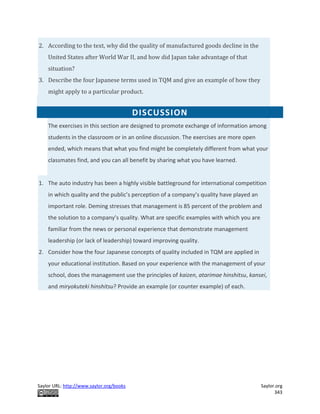
![Saylor URL: http://www.saylor.org/books Saylor.org
344
Chapter 11
Managing Project Risk
Project managers must be prepared to deal with adversity. Planning for events that that
can delay a project, decrease its quality, or increase its budget is a necessary part of project
planning.
11.1 Defining Risk
LEARNING OBJECTIVES
1. Define project risk.
2. Define the difference between known and unknown risks.
3. Describe the difference between the business risk of the organization and project risk.
Risk is the possibility of loss or injury. [1] Project risk is an uncertain event or condition
that, if it occurs, has an effect on at least one project objective. [2] Risk management focuses
on identifying and assessing the risks to the project and managing those risks to minimize](https://image.slidesharecdn.com/projectmanagement-fromsimpletocomplex-150108153836-conversion-gate02/85/Project-management-from-simple-to-complex-344-320.jpg)
![Saylor URL: http://www.saylor.org/books Saylor.org
345
the impact on the project. There are no risk-free projects because there is an infinite
number of events that can have a negative effect on the project. Risk management is not
about eliminating risk but about identifying, assessing, and managing risk.
Tzvi Raz, Aaron Shenhar, and Dov Dvir [3] studied the risk management practices on one
hundred projects in a variety of industries. The results of this study suggested the following
about risk management practices:
Risk management is not widely used.
The projects that were most likely to have a risk management plan were those that were
perceived to be high risk.
When risk management practices were applied to projects, they appeared to be positively
related to the success of the project.
The risk management approach influenced the meeting of project schedules and cost goals
but exerted less influence on project product quality.
Good risk management increases the likelihood of a successful project.
Risk deals with the uncertainty of events that could affect the project. Some potential
negative project events have a high likelihood of occurring on specific projects. Examples
are as follows:
Safety risks are common on construction projects.
Changes in the value of local currency during a project affect purchasing power and
budgets on projects with large international components.
Projects that depend on good weather, such as road construction or coastal projects, face
risk of delays due to exceptionally wet or windy weather.
These are examples of known risks. Known risks are events that have been identified and
analyzed for which advanced planning is possible. Other risks are unknown or unforeseen.
Terrorist Attack](https://image.slidesharecdn.com/projectmanagement-fromsimpletocomplex-150108153836-conversion-gate02/85/Project-management-from-simple-to-complex-345-320.jpg)

![Saylor URL: http://www.saylor.org/books Saylor.org
347
Project risk is the possible outcome that planned events on the project will not occur
as planned or that unplanned events will occur that will have a negative impact of the
project.
Known risks can be identified before they occur, while unknown risks are unforeseen.
Organizational risks are associated with the business purpose of the project and
assumed by the client when deciding to do the project.
EXERCISES
1. According to PMI, project risk is a(n) ___________ event or condition that, if it occurs,
has an effect on at least one project objective.
2. A risk such as the future market price of a commodity is an example of a(n) _________
risk.
3. Define risk in your own words.
4. Give an example of a known risk and an unknown risk that are different from those in
the text.
5. Describe the difference between organizational risk and project risk in your own
words and give an example of each that is not used in the text.
Planning for Known and Unknown Risks
Consider a trip that you might be planning. Describe at least five risks that are
associated with taking the trip.
[1] Merriam-Webster Online, s.v. “risk,” http://www.merriam-
webster.com/dictionary/Risk (accessed August 21, 2009).
[2] Project Management Institute, Inc., A Guide to the Project Management Body of Knowledge
(PMBOK Guide), 4th ed. (Newtown Square, PA: Project Management Institute, Inc., 2008), 273.
[3] Tzvi Raz, Aaron J. Shenhar, and Dov Dvir, “Risk Management, Project Success, and
Technological Uncertainty,” R&D Management 32 (2002): 101–12.](https://image.slidesharecdn.com/projectmanagement-fromsimpletocomplex-150108153836-conversion-gate02/85/Project-management-from-simple-to-complex-347-320.jpg)
![Saylor URL: http://www.saylor.org/books Saylor.org
348
11.2 Risk Management Process
LEARNING OBJECTIVES
1. Identify the major elements in managing project risk.
2. Describe the processes for identifying project risk.
3. Describe the processes for evaluating risk.
4. Describe the processes for mitigating risk.
Managing risks on projects is a process that includes risk assessment and a mitigation
strategy for those risks. Risk assessment includes both the identification of potential risk
and the evaluation of the potential impact of the risk. A risk mitigation plan is designed to
eliminate or minimize the impact of the risk events—occurrences that have a negative
impact on the project. Identifying risk is both a creative and a disciplined process. The
creative process includes brainstorming sessions where the team is asked to create a list of
everything that could go wrong. All ideas are welcome at this stage with the evaluation of
the ideas coming later.
Risk Identification
A more disciplined process involves using checklists of potential risks and evaluating the
likelihood that those events might happen on the project. Some companies and industries
developed risk checklists based on experience from past projects. The Construction
Industry Institute [1] developed a detailed checklist of potential risks based on the
experience of several large construction companies executing major construction projects.
These checklists can be helpful to the project manager and project team in identifying both
specific risks on the checklist and expanding the thinking of the team. The past experience
of the project team, project experience within the company, and experts in the industry can
be valuable sources for identifying potential risk on a project.](https://image.slidesharecdn.com/projectmanagement-fromsimpletocomplex-150108153836-conversion-gate02/85/Project-management-from-simple-to-complex-348-320.jpg)
![Saylor URL: http://www.saylor.org/books Saylor.org
349
Identifying the sources of risk by category is another method for exploring potential risk on
a project. Some examples of categories for potential risks include the following:
Technical
Cost
Schedule
Client
Contractual
Weather
Financial
Political
Environmental
People
The people category can be subdivided into risks associated with the people. Examples of
people risks include the risk of not finding the skills needed to execute the project or the
sudden unavailability of key people on the project. David Hillson [2] uses the same
framework as the work breakdown structure (WBS) for developing
a risk breakdown structure (RBS). A risk breakdown structure organizes the risks that have
been identified into categories using a table with increasing levels of detail to the right.
Risks in John’s Move
In John’s move, John makes a list of things that might go wrong with his project and uses
his work breakdown structure as a guide. A partial list for the planning portion of the RBS
is shown below.
Figure 11.1Risk Breakdown Structure (RBS)](https://image.slidesharecdn.com/projectmanagement-fromsimpletocomplex-150108153836-conversion-gate02/85/Project-management-from-simple-to-complex-349-320.jpg)


![Saylor URL: http://www.saylor.org/books Saylor.org
352
There is a positive correlation—both increase or decrease together—between project risk
and project complexity. A project with new and emerging technology will have a high-
complexity rating and a correspondingly high risk. The project management team will
assign the appropriate resources to the technology managers to assure the
accomplishment of project goals. The more complex the technology, the more resources the
technology manager typically needs to meet project goals, and each of those resources
could face unexpected problems.
Risk evaluation often occurs in a workshop setting. Building on the identification of the
risks, each risk event is analyzed to determine the likelihood of occurring and the potential
cost if it did occur. The likelihood and impact are both rated as high, medium, or low. A risk
mitigation plan addresses the items that have high ratings on both factors—likelihood and
impact.
Risk Analysis of Equipment Delivery
For example, a project team analyzed the risk of some important equipment not arriving to
the project on time. The team identified three pieces of equipment that were critical to the
project and would significantly increase the costs of the project if they were late in arriving.
One of the vendors, who was selected to deliver an important piece of equipment, had a
history of being late on other projects. The vendor was good and often took on more work
than it could deliver on time. This risk event (the identified equipment arriving late) was
rated as high likelihood with a high impact. The other two pieces of equipment were
potentially a high impact on the project but with a low probably of occurring.
Not all project mangers conduct a formal risk assessment on the project. There are barriers
to identifying risks. David Parker and Alison Mobey [3] found in a phenomenological study
of project managers that there was a low understanding of the tools and benefits of a
structured analysis of project risks. The lack of formal risk management tools was seen as a](https://image.slidesharecdn.com/projectmanagement-fromsimpletocomplex-150108153836-conversion-gate02/85/Project-management-from-simple-to-complex-352-320.jpg)





![Saylor URL: http://www.saylor.org/books Saylor.org
358
Risk evaluation prioritizes the identified risks by the likelihood and the potential
impact if the event happens.
Risk mitigation is the development and deployment of a plan to avoid, transfer, share,
and reduce project risk. Contingency planning is the development of alternative plans
to respond to the occurrence of a risk event.
EXERCISES
1. A risk ___________ plans eliminates or minimizes the impact of risk events.
2. Risk management is a creative process that involves identifying, evaluating, and
__________ the impact of risk events
3. A process for risk assessment that is parallel to the WBS is a _________ _______
_______ (three words).
4. Choose a project risk that could be related to the John’s move example that is not
described in the text and describe a mitigation plan for that risk. You may choose from
any part of the John’s move example that has been described in previous chapters.
5. If you are planning a party at your residence, list three project risks and rate each of
them for their potential impact and likelihood. Use high, medium, and low.
6. Describe the similarities and differences between risk transfer and risk sharing.
Risk Management
Assume that you are involved in planning a wedding. What are three risks that might
affect the ceremony or reception, and how would you mitigate the impact of those
risks? For example, if you are planning an outdoor wedding, describe the backup plan
in case of rain.
[1] Construction Industry Institute Cost/Schedule Task Force, Management of Project Risks and
Uncertainties(Austin, TX: Construction Industry Institute, 1989).](https://image.slidesharecdn.com/projectmanagement-fromsimpletocomplex-150108153836-conversion-gate02/85/Project-management-from-simple-to-complex-358-320.jpg)
![Saylor URL: http://www.saylor.org/books Saylor.org
359
[2] David Hillson, “Using a Risk Breakdown Structure in Project Management,” Journal of
Facilities Management 2, no. 1 (2003): 85–97.
[3] David Parker and Alison Mobey, “Action Research to Explore Perceptions of Risk in Project
Management,” International Journal of Productivity and Performance Management 53, no. 1
(2004): 18–32.
11.3 Project Risk by Phases
LEARNING OBJECTIVES
1. Describe the elements of risk management during the initiation phase.
2. Describe the elements of risk management during the planning phase.
3. Describe the elements of risk management during the execution phase.
4. Describe the elements of risk management during the closeout phase.
Project risk is dealt with in different ways depending on the phase of the project.
Initiation Phase
Risk is associated with things that are unknown. More things are unknown at the beginning
of a project, but risk must be considered in the initiation phase and weighed against the
potential benefit of the project’s success in order to decide if the project should be chosen.
Risks by Phase in John’s Move
In the initiation phase of John’s move, John considers the risk of events that could affect the
whole project. He identifies the following risks during the initiation phase that might have a
high impact and rates the likelihood of their happening from low to high.
1. His new employer might change his mind and take back the job offer after he’s given notice
at his old job: Low.](https://image.slidesharecdn.com/projectmanagement-fromsimpletocomplex-150108153836-conversion-gate02/85/Project-management-from-simple-to-complex-359-320.jpg)






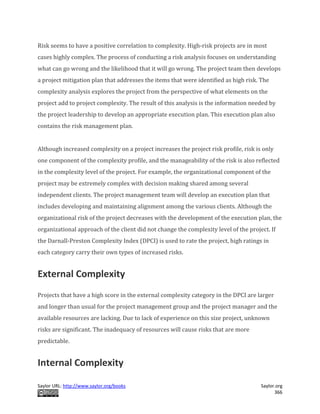



![Saylor URL: http://www.saylor.org/books Saylor.org
370
Chapter 12
Project Procurement and Closure
To achieve the objectives of the project, the management team will purchase goods and
some services. The process of obtaining goods and services from providers who are outside
of the organization is procurement. This chapter discusses the process for selecting the
work that will be procured and the different methods and processes for procuring the
equipment, materials, and services for the project.
12.1 Identifying the Need for Resources
Outside the Organization
LEARNING OBJECTIVES
1. Identify the factors that are considered when deciding whether to buy goods from
within the organization or to obtain them from outsiders.
2. Identify what factors are considered when deciding to outsource or perform the work
within the organization.
The project team decides the work that will be self-performed—performed by members of
the project team—and the work that will be outsourced to others. The procurement
strategy focuses on the work that will be outsourced—performed by outsiders.
Luu, Ng, and Chen [1] studied project procurement selection priorities and identified budget
and schedule as the most important considerations in the decision to outsource activities.
This study of construction projects also identified other items that project managers must](https://image.slidesharecdn.com/projectmanagement-fromsimpletocomplex-150108153836-conversion-gate02/85/Project-management-from-simple-to-complex-370-320.jpg)


![Saylor URL: http://www.saylor.org/books Saylor.org
373
The factors that influence procurement are primarily cost and schedule but also
include risk, quality, and flexibility.
To determine whether to outsource or do the work within the organization, consider
which option is less costly and which option can deliver the work on time.
EXERCISES
1. The primary factors that influence procurement are cost and ____________.
2. In addition to the two primary factors that influence procurement, what are three
other important factors?
3. What is one advantage of doing the work within the organization instead of
outsourcing it?
Internalize your learning experience by preparing to discuss the following.
Choose a situation with which you are familiar where you or your organization chose
to hire someone outside your organization instead of developing the skill yourselves.
What factors were most important in making the choice and how do they relate to the
factors described in this section?
[1] Duc Thanh Luu, S. Thomas Ng, and Swee Eng Chen, “Parameters Governing the
Selection of Procurement System,” Journal of Engineering, Construction, and
Architectural Management 10, no. 3 (2003): 209–18.
12.2 Procurement Plan
LEARNING OBJECTIVES
1. Describe the role of suppliers.
2. Describe the role of vendors.
3. Describe the role of partners.](https://image.slidesharecdn.com/projectmanagement-fromsimpletocomplex-150108153836-conversion-gate02/85/Project-management-from-simple-to-complex-373-320.jpg)

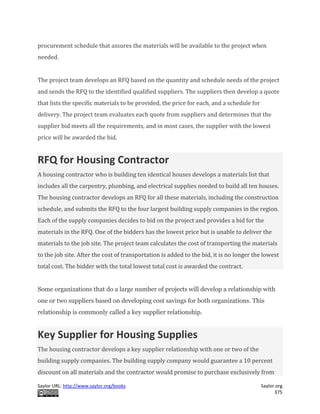

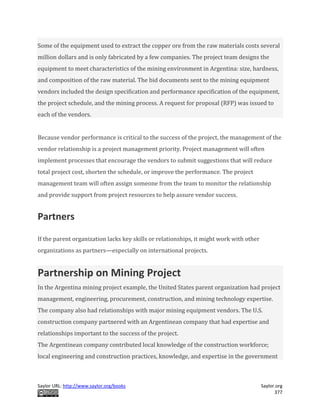





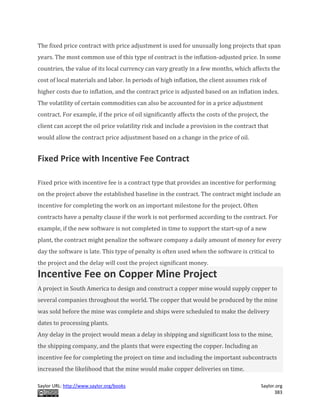





![Saylor URL: http://www.saylor.org/books Saylor.org
389
deliver excellence and innovative technology solutions to the world’s navies for years to
come.” [1]
Time and Materials Contracts
On small activities that have a high uncertainty, the contractor might charge an hourly rate
for labor, plus the cost of materials, plus a percentage of the total costs. This type of
contract is calledtime and materials (T&M). Time is usually contracted on an hourly rate
basis and the contractor usually submits time sheets and receipts for items purchased on
the project. The project reimburses the contractor for the time spent based on an agreed-
on rate and the actual cost of the materials. The fee is typically a percent of the total cost.
Time and materials contracts are used on projects for work that is smaller in scope and has
uncertainty or risk, and the project rather than the contractor assumes the risk. Since the
contractor will most likely include contingency in the price of other types of contracts to
cover the high risk, T&M contracts provide lower total cost to the project.
Figure 12.9 Table of Contract Types and Characteristics](https://image.slidesharecdn.com/projectmanagement-fromsimpletocomplex-150108153836-conversion-gate02/85/Project-management-from-simple-to-complex-389-320.jpg)



![Saylor URL: http://www.saylor.org/books Saylor.org
393
[1] VSE Corporation, “VSE Awarded $249 Million Cost-Plus Award Fee Contract Option
Modification by Navy,” Business Wire, August 24,
2009, http://www.businesswire.com/portal/site/home/permalink/?ndmViewId=news_view&n
ewsId=20090824006017&newsLang=en (accessed October 5, 2009).
12.4 Procurement Process
LEARNING OBJECTIVES
1. Describe the components of the procurement plan.
2. Identify the decisions made when selecting the type of contract.
3. Describe how bidders are qualified, solicited, and chosen.
4. Identify the methods used to manage the contracts.
The project procurement cycle reflects the procurement activities from the decision to
purchase the material or service through the payment of the bills and closing of
procurement contracts.
Procurement Plan
After the decision has been made to purchase goods or outsource services, the
procurement team develops a plan that includes the following:
Selecting the appropriate relationships and contract approaches for each type of purchased
goods or outsourced service
Preparing RFQs and RFPs and evaluating partnership opportunities
Evaluating RFQs, RFPs, and partnerships
Awarding and signing contracts
Managing quality, timely performance, and contract changes
Closing contracts](https://image.slidesharecdn.com/projectmanagement-fromsimpletocomplex-150108153836-conversion-gate02/85/Project-management-from-simple-to-complex-393-320.jpg)


















